
DIRECT IMPACT
The Musk Foundation awards 2.4 million to Brownsville ISD. p.24
JULIAN ALVAREZ
RGV’s jobs guru sees promising economic recovery in postCOVID-19 future. p.38
EXOTIC SURGERY IN THE RGV
Board-certified cosmetic surgeon holds the key to rib cage modification. p.62
GeTting History
New foundation connects local artists to community. p.72
JULY/AUGUST 2021 | VOLUME 13 ISSUE 4
The Best Choice





















Family Dentistry • Orthodontics • Pediatric Dentistry • Cosmetic Dentistry • Endodontics • Oral Surgery
Celebrations! Good Times! Great Vibes!

Celebrate Life



It's important to take the time to acknowledge the uniqueness of the deceased: the individuality of their personality, and the uniqueness of their life's path. Not just for them, but for you; it affirms the relationship, and leads to healing after loss. Honoring their life is truly an act of love – for the both of you.
Please contact us about any of our services or to meet with one of our funeral service professionals. You may contact our general office at (956) 583-6333, ricbrownffh@gmail.com or visit our website at www.RicBrownFFH.com.
We have continued the family tradition of helping families honor their loved ones in our community for over 20 years. - Kathy Brown, Tim & Barbara Brown
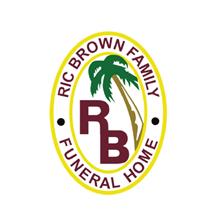
EVERY LIFE DESERVES A SPECIAL TIME OF HONORING AND CELEBRATING.





DR. FILIBERTO RODRIGUEZ Dr. Rodriguez and his team are committed to patient safety! Call 956-477-0628 to make your appointment today. www.rgvcosmetic.com 313 1 W. Freddy Gonzalez Dr. Edinburg, TX 78539 We offer the following procedures: • 1-Hour Breast Augmentation • VASERLipo® • Liposuction 360 • Body & Butt Lift Ask about our financing options SUMMER LOVIN’



GABE PUENTE PUBLISHER/CEO
Psalms 23:1-3
A psalm of David. "1 The Lord is my shepherd, I lack nothing. 2 He makes me lie down in green pastures, he leads me beside quiet waters, 3 he refreshes my soul. He guides me along the right paths for his name’s sake."
As hot as it may be here in the Rio Grande Valley, it truly is terrific to see people out again. This summer, we bring you more stories about positive change happening in the RGV. In this issue, you will read about what the Elon Musk Foundation is providing Brownsville to further enhance its school districts, what one rancher is doing to improve the quality of life through the arts, our "La Jefa" feature story, and much more.
We aim to provide a platform for the RGV to promote its growth as well as the success stories of the people who live here. We thank you for picking up this issue — and are glad you’ve done so. We hope that, by reading it, you stay informed, educated, and inspired.
For all our stories, go to www.rgvisionmagazine.com, and be sure to follow us.
PUBLISHER'S NOTE
If you are interested in receiving issues delivered to your home, please go to RGVisionMagazine.com/Subscribe or send us an email at info@ rgvisionmagazine.com to subscribe to RGVision for $6.50/month.
RGVISION
STAFF
DOMINIQUE Y. ZMUDA
GRAPHIC DESIGNER/ILLUSTRATOR / CONTENT MANAGER
YADIRA HERNANDEZ
GRAPHIC DESIGNER/ILLUSTRATOR/ SOCIAL MEDIA MANAGER
DANTE TUEXI
DIGITAL MANAGER
KELSEY GARCIA
CERTIFIED DIGITAL MARKETING AGENT/WRITER
MARK PUENTE
VIDEO PRODUCTION LEAD/PHOTOGRAPHER
WALDO PALOMARES
VIDEOGRAPHER/ PHOTOGRAPHER
Harlingen CISD
PSJA ISD
South Texas College
Brownsville ISD
Sergio Contreras
Leonardo Chang
Dr. Alfonso Mercado
Quinta Mazatlån
Amy Casebier
Rocio Villalobos
Nathaniel Mata
Janie Briones
Cori Smelker
Elisa Garcia
Steven Hughes
Jose De Leon III
Arturo Murillo
Alma Guerrero Barham
Bryan Kirk
Faith Chua
James Hord
Barbara Delgado
Melissa Guerra
Jason Garza
CONTENT CONTRIBUTORS WRITERS PHOTOGRAPHERS VISIT OUR WEBSITE RGVISIONMAGAZINE RGVISIONMAG Copyright by RGVision Publications Inc. All rights reserved. Reproduction without expressed written permission of the publisher is prohibited. The opinions and views expressed in the magazine don’t necessarily reflect those of our advertisers or collaborators. RGVision magazine is published bi-monthly and circulates 12,000 copies across the Rio Grande Valley in 450 locations with a direct mail distribution to major hospitals and Superintendents within Region 1. The RGVision office is located at 801 N. Bryan Road, Mission, TX 78572. For editorial comments and suggestions, please send emails to info@rgvisionmagazine.com. For advertising information, please call us at 956.431.0103 or email us at info@rgvisionmagazine.com. A special thank you to all the advertisers who support this publication: You are the power behind the flywheel igniting positive change that keeps the conversation going. PRINTED IN MEXICO
RGVISION MAGAZINE.COM

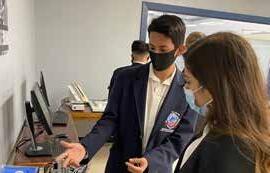


DIRECT IMPACT
The Musk Foundation awards 2.4 million to Brownsville ISD. JULIAN ALVAREZ
RGV’s jobs guru sees promising economic recovery in post-COVID-19 future.
EXOTIC SURGERY IN THE RGV Board-certified cosmetic surgeon holds the key to rib cage modification.
OF CONTENTS
TABLE
EDUCATION QUALITY OF LIFE HEALTH New foundation connects local artists to community. GETTING HISTORY ON THE COVER 72 24 38 62 2021 VOLUME 13 ISSUE 4 RGVISION MAGAZINE A District of Innovation pg 10 Remember Your Roots pg 12 A History of Excellence pg 14 Ethnic Studies pg 16 Behind the Scenes pg 18 Under Pressure pg 22 Financial Focus pg 26 Giving Back to the Community pg 28 Getting to know Furniture pg 30 Pizza Changing the Community pg 32 Stop Lawsuit Abuse pg 36 A Woman of Many Hats pg 41 Franke Realty pg 44 Stimulus Checks pg 48 LGBTQ+ Mental Health pg 50 My First Rodeo pg 54 Emergency Care pg 56 Compassionate Healthcare pg 58 The Evolution of Surgery pg 60 Rallying for a Cure pg 64 Getting Fit with Doctors pg 66 A Sight Better pg 68 Light at the End of the Tunnel pg 70 Blooming at Quinta Mazatlan pg 76 A Little Piece of Mexico pg 78 Montezuma Bald Cypress pg 80 Farm Sweet Farm pg 82 Apiary Buzz pg 84 Fish Fiorucci pg 88 The Migrant Life pg 92 Harlingen Art District pg 94 Fishers of Men pg 96
72 24 38 62
BUSINESS
RGVISION ADVISORY BOARD
Each and every member of our advisory board charges RGVision with growth and commitment within our business development, social engagement, and editorial efforts. Through their feedback and contributions, RGVision will continue to help tell and share the Rio Grande Valley’s stories and extend the invitation to join the conversation.













 TOM TORKELSON
MARK PETERSON
VERONICA VELA WHITACRE
ANDREA RODRIGUEZ
SABRINA WALKER HERNANDEZ
SARAH SAGREDOHAMMOND
EDDIE LUCIO III
MARITZA ESQUEDA
BILL MARTIN
RENE A. FLORES
JAVIER DE LEON
BYRON JAY LEWIS
ROBERT DUNKIN
TOM TORKELSON
MARK PETERSON
VERONICA VELA WHITACRE
ANDREA RODRIGUEZ
SABRINA WALKER HERNANDEZ
SARAH SAGREDOHAMMOND
EDDIE LUCIO III
MARITZA ESQUEDA
BILL MARTIN
RENE A. FLORES
JAVIER DE LEON
BYRON JAY LEWIS
ROBERT DUNKIN
8
DR. RENE I. LUNA

A DISTRICT OF INNOVATION AND INCLUSIVITY
HCISD Commemorates the Opening of the Transition Academy
by Ashley Berrones | photos provided
The ribbon-cutting ceremony for the HCISD Transition Academy kicked off to the beat of the Harlingen High School Jazz Band on the morning of April 29.
The Harlingen High School Coffee Club served guests as they arrived. Members from the district and the community gathered to celebrate the historic moment.
“Our transition academy is a true testament of our district’s commitment to innovation and a direct response to the needs of our students and our community,” Director of Special Education Dan Garza said. “There has been much support for this project and without our incredible school board and superintendents who

are committed to providing nothing but the best for our special needs students, this project would not have come to fruition. The outpouring of support from our Harlingen partners has been tremendous and we are forever grateful to be part of this community that is truly vested in our students.”
Superintendent Dr. Alicia Noyola shared what the vision for the transition academy was like from the beginning.
“Very early on, when we were having the discussion around this building, we did a lot of visits and looked at other places, but we never quite found what was right for Harlingen,” Noyola said.
She told the audience how
10 EDUCATION RGVISION MAGAZINE . JUL/AUG 2021
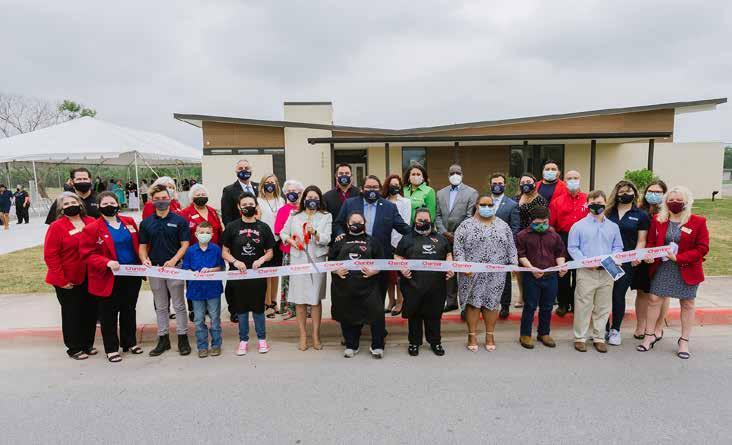
when discussing the plans for the transition academy, the previous superintendent, Dr. Art Cavazos would say, “No, think bigger. Think bigger.”
Then, Noyola held out her hand, palm side up, and gestured towards the custom-made home, the HCISD Transition Academy. “Bigger,” she said in response.
Several board members and a Transition Academy Committee member also addressed the audience at this event.
Board President Eladio Jaimez talked about how this home would impact the entire community.
“These buildings that we see, these facilities, they don’t benefit just the students, but they impact the entire community as a whole and make Harlingen a better place to live,” Jaimez said.
Board Secretary Bobby Muniz shared the meaning of this academy to his family and him.
“A lot of you know that I have a special needs child — Ariel,” Muniz said. “Ariel is 5 years old. She is a blessing to me and my family and to a lot of people in this community. When my wife was 17 weeks pregnant, they told us that she would not live, but I can tell you that she is alive
and thriving, and she will be part of the transition academy.”
Meredith Brownell, a teacher, parent, and HCISD Transition Academy committee member, shared additional details about what would be available for students through the transition academy.
“My son, Wyatt, who is here in the audience today, is a proud junior in the life skills program at Harlingen South,” Brownell said. “The opportunity that the academy is going to give my son and other students is just simply amazing. While at the house, students will be offered courses such as floral design, career prep 1 and 2, independent living, and practicum in business management. In the community, students will be able to work at places like Chick-Fil-A, Peter Piper Pizza, Home Depot, and Charlie Clark Nissan. Through this academy, students will develop skills that will enable them to participate successfully in society, and that has long been a goal of our district.”
After the ceremony, several groups of school and community members and future Transition Academy students took photos at the front of the house, cut the ribbon, and then toured the home.
“The opportunity that the academy is going to give my son and other students is just simply amazing. While at the house, students will be offered courses such as Floral Design, Career Prep 1 and 2, Independent Living, and Practicum in Business Management."
Meredith Brownell, a teacher, a parent, and an HCISD Transition Academy committee member

To learn more about the HCISD Transition Academy, visit: www.hcisd.org/TA
11 RGVISION MAGAZINE . JUL/AUG 2021 EDUCATION
REMEMBER YOUR ROOTS
PSJA ISD Alumni, Brothers Return to Their High School, Paying Tribute to Where Their Educational Journey Began
Three Rio Grande Valley brothers returned home and recently made time to visit their alma mater, PSJA Early College High School in San Juan, after recently graduating from various universities across the state and nation.
The brothers and proud PSJA Bears, Dr. Jesus Guzman Jr. (Class of 2011), Alan Guzman (Class of 2015), and Juan Guzman (Class of 2017), were excited to be home and give thanks for the education they received while at PSJA ISD after recently completing their post-secondary dreams.
According to their mother, Lorena Guzman, she is proud to see them continue to have pride in their roots as they succeed.
“We are so proud of our children for their efforts and dedication in making their dreams a reality,” Guzman said. “The college classes they were able to take at PSJA ISD were part of the foundation that inspired them to strive more for their future and continue their studies. Thank you to all of their PSJA ISD teachers since elementary to high school. Even now, they still get in touch with their counselors. They are always there to support them or answer their questions about college.”
While at PSJA ISD, Dr. Jesus Guzman Jr. earned an associate’s degree of science in interdisciplinary studies from South Texas College. He then earned a Bachelor of Science in molecular & cell biology from Texas A&M University in 2014 and a Master of Science in veterinary pharmacology & physiology from Texas
A&M University in 2016. Most recently, the 28-year-old graduated with a doctorate in osteopathic medicine from Burrell College of Osteopathic Medicine in New Mexico. He will be starting a residency this fall in family medicine at the University of New Mexico School of Medicine.
“To me, being part of PSJA ISD means I had the privilege of growing up in a tightknit community, bicultural and bilingual,” said Dr. Guzman Jr. “All those experiences helped shape me into who I am today.”
Inspired by his older brother and the education he received, Alan Guzman graduated from PSJA ISD with an associate’s degree in interdisciplinary studies in 2015 from STC. He earned a Bachelor of Science in biomedical science from Texas A&M University-College Station in 2018. In addition, he recently graduated with a Master of Science in biomedical science from Texas Tech University Health Sciences Center-El Paso. He plans to start medical school this fall at Texas Tech University Health Sciences Center-El Paso Paul L. Foster School of Medicine.
Continuing in his brothers’ footsteps, Juan Guzman graduated from PSJA ISD in 2017 with an associate’s degree in mathematics from STC. He recently graduated with a Bachelor of Science in chemical & biomolecular engineering and a Bachelor of Arts in history from Johns Hopkins University. He plans to pursue a Master of Science in engineering management at Johns Hopkins University.
“PSJA ISD opened the doors for me
to pursue higher education and gave me the skills to succeed four years later and beyond,” the 21-year-old said.
Through partnerships with South Texas College and other higher education institutions, more than 3,500 PSJA ISD high school students are enrolled in college courses each semester through the district’s nationally recognized Early College Program. College courses continued virtually during the 2020-21 school year despite the pandemic.
Due to their accomplishments, the brothers wanted to return to visit their high school during a celebratory trip to the Rio Grande Valley for their graduations. They, like their parents, credit part of their educational successes to the start and opportunities they had at PSJA ISD.
“To my PSJA family and future graduates, keep on working hard, aim high, and remember your roots,” Alan Guzman said. “Once a Bear, always a Bear!”
576
PSJA ISD students were named candidates for associate degrees and certificates from South Texas College during the 2020-21 school year.
To learn more about this program, visit: PSJAISD.US/EarlyCollege


12 EDUCATION RGVISION MAGAZINE . JUL/AUG 2021

13 RGVISION MAGAZINE . JUL/AUG 2021 EDUCATION

A HISTORY OF EXCELLENCE
Numerous Top National and Statewide Honors Awarded to South Texas College For First Half of 2021
South Texas College has already received significant rankings for the first half of 2021. Along with being recognized as No. 1 in the nation for Most Affordable Online College for Bachelor Degrees, STC has also been named No. 1 in the nation for Most Affordable Associate Degree in Nursing Program.
14 EDUCATION RGVISION MAGAZINE . JUL/AUG 2021
The rankings are in. South Texas College has achieved significant honors so far for 2021, placing the college among the best when it comes to affordability as well the quality of its online campus, bachelor’s degrees, nursing program, and many more.
Nearing the midpoint of the year, STC ranks:
• No. 1 in the nation for “Most Affordable Online College for Bachelor Degrees” by Online College Plan.
• No. 1 in the nation for “Most Affordable Associate Degree in Nursing Program” by NursingSchoolHub.
• No. 1 in Texas as 2021 “Best Online Community College” by Premium Schools.
• No. 2 for “Safest College Campuses in Texas” by Niche Rankings.
• Top 15 (out of 60+) BEST LVN Programs in Texas according to 2021 nursingprocess.org.
“It is no small task to achieve such growth with nationally merited scholarship and excellence,” STC interim president Dr. David Plummer said. “It takes bold planning, creative ideas, committed partnerships, outstanding faculty and staff, a supportive Board of Trustees, and an unwavering commitment to transform the quality of life in our communities.”
South Texas College has a storied history of being recognized and honored for its dedication to excellence and its innovative endeavors. The college has received numerous awards from national, state, and local organizations within its first 27 years of existence, which confirm STC’s leadership among the community colleges in the state of Texas and the nation.
Since its creation, STC has expanded to include over 28,000 students each semester on five campuses in Hidalgo and Starr counties — along with the STC Regional Center for Public Safety Excellence, two higher education centers, and a virtual campus.
STC offers 127 degree and certificate options, 36 fully online programs, and is authorized by the Texas Higher Education Coordinating Board to offer Bachelor of Applied Technology and Bachelor of Applied Science degrees.
"I am beyond honored with all of these huge accomplishments despite the COVID-19 situation,” STC Dean of Nursing and Allied Health Dr. Jayson Valerio said. “NAH faculty and staff continuously live up to South Texas College’s mission and its core values in light of the pandemic situation."
For a full list of STC’s achievements, awards, rankings, and accreditations, visit www.southtexascollege.edu/ excellence/.
ABOUT SOUTH TEXAS COLLEGE
Founded in 1993, South Texas College is accredited by the Commission on Colleges of the Southern Association of Colleges and Schools and offers more than 127 degree & certificate options, including associate degrees in a variety of liberal art, social science, business, math, science, technology, advanced manufacturing and allied health fields of study. Additionally, South Texas College is the only community college in the State of Texas to offer five baccalaureate degrees. South Texas College has a faculty and staff of more than 2,700 to serve 28,000 students, on the college’s six campuses, two higher education centers, and one virtual campus.
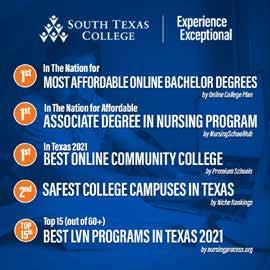
15 RGVISION MAGAZINE . JUL/AUG 2021 EDUCATION

ETHNIC STUDIES
COURSE COMING TO MCALLEN ISD
McAllen Students Offered Education on Black, Hispanic Culture
by Nathaniel Mata
Students in McAllen will have an opportunity to learn about culture, history, and heritage with new classes in the high school course catalog.
McAllen ISD is taking the leap and adding two new social studies electives. The school district is adding Mexican-American studies and African-American studies courses for upperclassmen.
“This is really good to bring to our community for students because typically ethnic studies classes are only offered at the college level,” said Clarissa Abbott, social studies coordinator for the district. “So the fact that the state has moved forward with providing these classes at the high school level is something we’re really excited about.”
The Texas Essential Knowledge and Skills state standards associated with the classes are newly updated or introduced within the last two years, making McAllen ISD an early adapter to offer these subjects.
The TEA website states these courses teach the history and cultural contributions from these people groups.
“To support the teaching of the essential
knowledge and skills, the use of a variety of rich primary and secondary source material, such as biographies, autobiographies, landmark cases of the U.S. Supreme Court, novels, speeches, letters, diaries, poetry, songs, and artworks are encouraged,” the website adds.
“We are all about providing more opportunities for our students,” Abbott said. “When the state came out with these new courses, we knew for sure that we wanted to provide them to our students. These are coming to use from the Texas Education Agency as courses for social studies. They are considered electives and they are offered for any 10th- through 12th-grade student.”
Abbott says a committee decided on course materials and instructors will be selected during the summer. She said most of the time, social studies electives don't get much excitement. This time, however, both students and instructors are trying to get into these sections.
“Right now we are in the process of recruiting instructors and students,” she said. “We’ve already selected our
instructional materials as a committee and they were approved by our school board. We’ll have teachers trained in August and we’ll be ready to begin the course in August for the 2021-22 school year. So many teachers signed up that we’ll be selecting who actually gets a section of instruction.”
A Push from Former Students
Prior to the announcement of ethnic studies at McAllen ISD, a group of McAllen graduates called The Grande Narrative pushed for more Black and MexicanAmerican lessons in the district. The timing aligned because Abbott informed the group these classes became available for districts to teach with state guidance.
“They wanted us to go in and revamp our curriculum and instead of that, we actually have two additional courses,” Abbott said. “I think we’ll be able to go into more depth doing it this way.”
The activist group that lifts the voice of young people examining and critiquing the status quo hailed the introduction of these classes as a win for the people of the RGV.
Extra Details
“They are able to take these courses and they count toward their ranking credit points," Abbott said of how the electives will work with students’ course loads. "Most electives don’t count for ranking but since these are considered social studies ‘core courses,’ you still get ranking points. That just shows that we are really honoring these classes and treating them with the importance they deserve.”
Abbott confirmed that these classes will be offered at McAllen High, McAllen Memorial High, James Nikki Rowe High, and Lamar Academy. Achieve Early College students also can enlist in a course and take it at one of the other campuses.

16 EDUCATION RGVISION MAGAZINE . JUL/AUG 2021

What’s Going on Down There?
Yes, down there! Why does talking about women’s sexual function make even qualified doctors squirm, just as much as it does the rest of us. Yet, we do not blink an eye watching the sex-capades of reality TV. Or hearing about a celebrity’s IVF or menopausal woes.
There is nothing wrong with sharing your concerns with a knowledgeable, trustworthy, and empathetic physician when it comes to your vagina. Oh yes, I said the V word! Dr. Troy Hailparn is a leader in her field regarding women’s sexual function, appearance and genital health.
She gives women back their pre-childbirth body function along with their confidence. “When a woman feels good about her body, her self-confidence shines through in every aspect of her life. She may be Mommy all day, but she is still a woman”
She wants to empower women to be aware of their options, seek the right treatment, and receive the care they deserve.
• Vaginal Rejuvenation Non-Surgical/Surgical
• Labiaplasty Minora & Majora Reduction
• Clitoral hood reduction – reconstruction
• O-Shot
• ThermiVa
 Troy Robbin Hailparn,M.D. Board Certified Female OB/GYN
Troy Robbin Hailparn,M.D. Board Certified Female OB/GYN







210.615.6646 info@cosmeticgyn.net
Oak Centre Drive – Suite 220 San Antonio, Texas 78258
www.cosmeticgyn.net
525
DOWNLOAD OUR ISSUE issuu.com/rgvisionmagazine
BEHIND THE SCENES
RGV Paraprofessionals Take on More Roles in Pandemic Learning
by Amy Casebier | photos provided
Actors may receive the king’s share of accolades for a theater performance, but where would they be without the director, scriptwriter, prop master, wardrobe, stagehands, and other essential crew members running the show in the wings?
Paraprofessionals function as that backstage muscle but in schools, working behind the scenes to keep everything going.
Without them, things wouldn’t be pretty. Or functional.
“A day without paraprofessionals. It’d be pretty much impossible. It would be rough,” said Anayancy Martinez, a pre-K special education teacher for Edinburg CISD. She relies on her pair of paraprofessionals to help guide her young students during lessons, hand out materials and manipulatives, help with meals, keep order in the

18 EDUCATION RGVISION MAGAZINE . JUL/AUG 2021
Priscilla Camarillo, Nora Treviño, and Anayancy Martinez, Lee Elementary ECSE CLASS
classroom, and assist with bathroom breaks and diaper changes.
“They are multitaskers,” Martinez said. “If they were not here, I would probably be like [actor Arnold Schwarzenegger in the movie] Kindergarten Cop, where they’re running around. That’s how I picture it.”
As COVID-19 reshaped how — and where — students learn and how educators teach the curriculum, paraprofessionals and other support staff had to evolve, too.
Raul Cardenas remembers being initially excited to hear that his spring break vacation was being extended another week in 2020. He was working as a teacher’s aide in Donna ISD at the time — he teaches now. But back then, he became more and more concerned as the school district — like others throughout the Rio Grande Valley and the rest of the state and country — continued to adjust how it would be delivering lessons to students.
“Something that started going through my mind was, well, the students I work with for the position that I had, I was helping students who needed accommodations,” Cardenas said. “That was going to be a little bit harder to do if we weren’t going to be there in person. I’m also an hourly employee — I was a little bit worried about that.”
Donna ISD administrators communicated with all staff members about documenting hours worked and how their roles would shift in response to an unprecedented situation. Then, Cardenas and his fellow paraprofessionals got to work. They gathered textbooks, workbooks, and other materials to distribute to students and their parents and took inventory of existing items at the school. They also called students and parents to make sure everyone was on the same page when it came to what they needed to be working to complete assignments while learning at home.
“It’s definitely another hat that I had to wear,” Cardenas said.
Schools leaned heavily on paraprofessionals’ versatility and willingness to help particularly during the pandemic.
Martinez recalled some staff members at her campus being pulled into classrooms as substitute teachers when other substitutes were unable or unwilling to fill in for missing teachers. Other paraprofessionals there acted as assistants to the school nurse in taking temperatures and asking in-person students about any possible symptoms or exposure to COVID. Paraprofessionals also delivered students’ meals to them, enabling students to stay within their areas — and 6 feet apart from their classmates, as recommended by social distancing guidelines.
“They were given a lot more duties than usual,” Martinez said.
Matthew Garcia, an inclusion teacher’s assistant at AP Solis Middle School in Donna, thrived with the additional responsibilities he took on during the pandemic.
“We’re the jack-of-all-trades here — especially more this year,” he said. “In a moment’s notice, things can change.”
Garcia has found himself monitoring the hallways for in-person students, manning the desk for a short-staffed front office, keeping distance-learning students on task, and shuttling them to virtual small group work sessions if they get lost. His teacher has also entrusted him to continue leading the online lesson if something happens — like an internet connectivity issue or a meeting that requires the teacher to leave the computer.
“It’s definitely challenging but, all in all, it’s a totally different learning experience,” Garcia said, remarking about figuring out how to operate Google Classroom as he went along — and right alongside his teacher.
Garcia’s mother worked as a paraprofessional for 13 years, describing her life skills TA role as not much more than standing in a corner and making copies whenever the teacher needs them. These days, Garcia finds his position is more highly involved. His teacher bounces instructional ideas off of him and regularly asks for his input and feedback.
“The kids don't see me as a TA. They count me as a teacher,” he said. “I’m not and


 Francisca Davila Hinojosa, Edinburg North High School
Catarina Lynn Stevens, TA special education, South Texas ISD Science Academy
Francisca Davila Hinojosa, Edinburg North High School
Catarina Lynn Stevens, TA special education, South Texas ISD Science Academy
19 RGVISION MAGAZINE . JUL/AUG 2021 EDUCATION
Matthew García, TA special education, A.P. Solis Middle School in Donna
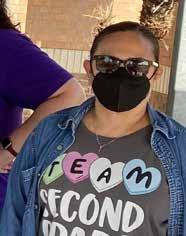


I admit it — I’m not the teacher — but they respect me as one.” During Teacher Appreciation Week from May 3 to May 7, many of his students thanked him, told him he was awesome, and even referred to him as “our second science teacher,” he said. “If they need it, I got it. That’s what I love about it. That’s what makes the day good, that little message at the end of the period: ‘goodbye, sir, have a good day.’”
Martinez also counts her paraprofessionals as additional teachers in her classroom.
“Without them, my class doesn’t run. I need them in my class in order for me to be able to do my job,” she
said. “Just like everybody thanks teachers for everything that they do, the positions that require paraprofessionals, that’s for a reason and we need them in the class. Without them, more students would definitely not be able to get everything that they get out of the class.”
Whether students’ parents and the rest of the community realize it, paraprofessionals’ work in the wings keeps everything running smoothly at schools across the Valley — even during an unprecedented academic year.
“It’s been a difficult year for everybody,” Cardenas said. “A lot of the TAs I feel do put in an enormous amount of work. But I feel like that recognition isn’t there.”
“We’re the jack-of-all-trades here — especially more this year. In a moment’s notice, things can change.”
Matthew García, TA special education, A.P. Solis Middle School in Donna
Nellie Rodriguez, IDEA Mission Academy
Front to back: Amelia Gomez, Francisca Davila Hinojosa, and Maribel Gonzalez
Janie Gomez, Travis Elementary
20 EDUCATION RGVISION MAGAZINE . JUL/AUG 2021





























































Ernesto Salomon Salutatorian Texas A&M San Antonio Ana Paula Villicana Valedictorian UT Austin Alyssa Castor UT Austin Ana L. Elizondo UTRGV Jaysen Garcia Texas A&M Julissa Araiza UTRGV Michael Gomez UTSA Stephanie Tovar UTRGV LeRoy Garza, Jr. UTRGV Kayla Montemayor UTSA Daniela Villarreal Salutatorian Texas A&M Iris Ambuehl Valedictorian Johns Hopkins Josue A. Lopez UTRGV Kristina Gomez UTSA Jennifer Bernal UT Austin Kalynna Sanchez UTRGV Catherine DiGrazia TCU Eduardo Lemus UTRGV Kayla Montemayor UTRGV Daniel Estrada US Air Force Kaleb Galvan Salutatorian UTSA Melenie Mendez Rangel Valedictorian Cornell University Alyzia K. Alvarado Salutatorian UT Austin Sofia R. Leal Cavazos Valedictorian UT Austin Max Sanchez UT Austin Kadence Gonzalez UTRGV Emannuel Rivera UTRGV Yahir Martinez UT Austin Sherlyn R. Perez UTRGV Mario Torres UT Austin Celeste I. Valle UTRGV Ximena Rocha UTRGV Aaron Medrano Salutatorian UTRGV Benjamin Martinez Valedictorian Rice University Noah Gongora Texas A&M Valeria Gonzalez UTRGV Janelle Perez UTRGV Bianca Mora UT Austin Kathryn Rodriguez UTRGV Yaritza Gutierrez UTRGV Freyda Perez Texas A&M San Antonio Rosalia Garcia UTRGV Natali Acha Texas A&M San Antonio Lyshaa Reyes UTSA Lily Rodriguez UT Austin Daniela Sanchez UT Austin Melissa Garza Texas A&M Maria Ramos UTRGV Karen A. Carrazco Northeastern University Kelly Gonzalez UTRGV PSJA EARLY COLLEGE HS TOP 10 STUDENTS PSJA NORTH EARLY COLLEGE HS TOP 10 STUDENTS PSJA MEMORIAL ECHS TOP 10 STUDENTS PSJA T. JEFFERSON T-STEM ECHS TOP 10 STUDENTS PSJA SOUTHWEST ECHS TOP 10 STUDENTS Congratulations PSJA ISD Class of 2021!
UNDER PRESSURE
Local Educators Eye Learning Loss Concerns Following Challenging Pandemic School Year
by Amy Casebier
MATH
Kristin Keith, an English teacher at Donna North High School, laughed as she described an interaction with one of her students during the past school year. He told her he’d seen her shopping at Walmart over the weekend. She informed him that she wouldn’t have known him from any of the other high school-aged shoppers because he never turned on his device’s camera during class — as is the case with many of her students. It isn’t a district requirement.
But that leads to a less funny issue.
“It’s hard to build rapport with your students — it takes a lot longer,” she said. “That’s been a struggle for me. How can I get these kids to do the things they’re supposed to do when I can’t create the relationships with them that I usually do?”
In her 13 years as a teacher, Keith has learned that good classroom management — including discipline and structure — enables kids to be more productive. Even as she strives to maintain some semblance of that in her virtual classroom, it obviously isn’t the same.
“It’s frustrating from a standpoint of I know I have students that are way more intelligent and way brighter than what their grades are showing and in my opinion, it’s an
attitude of apathy for most of them,” Keith said. “I get it — I’m a person that thrives on routine. Kids thrive on structure and routine.”
Education experts and leaders across the RGV and country are watching the phenomenon of “learning loss” — something that usually takes place naturally between grade levels, when students take their summer breaks and forget some of what they learned the previous year. When some students haven’t been in a physical classroom for a year-and-a-half, however, learning loss may become even more of a problem.
More than half of public school teachers are seeing “significant” learning loss for kindergarten through 12th-grade students, a report from educator-centric insurance corporation Horace Mann finds.
“We see it. There’s drastic, drastic gaps,” said Yvette Banda, an academic coach at Ruben Hinojosa Elementary School in Mercedes. The biggest impact at her campus has been for pre-K through second-grade students, who usually learn the fundamentals during individualized instruction and small group work in person with their teacher every day. “That has not been able to happen this year.”
One example, she said, is the transition between first and second grade. Students who would usually leave the first grade as fluent readers aren’t reading yet, creating an issue for second grade. Math, a usually strong subject for the campus, is another issue.
"Concepts and things they would’ve grasped probably in face-to-face instruction, now they’re just lagging behind,” Banda said. “First we have to figure out specific gaps, which is what we’re trying to do with any testing we’re giving. What is it that students didn’t get? From there we plan accordingly.”
For Banda’s campus, that would include supplementing regular instruction with small groups to address deficits — and continuing to offer additional support through intervention blocks.
Parents needed help getting up to speed with the unprecedented school year, too.
“I was on the phone every day with parents from the morning to the afternoon because parents didn’t know how to tackle the technology,” Banda said. “They’d come to the building, we’d show them, we’d train them, we’d create their accounts on the devices.”
Mercedes ISD was able to fill a technology gap during the 2020-21 school year, ensuring that students had access to devices to learn remotely. Banda looks forward to leveraging that new connectivity in a healthy way in classrooms. More than that, though, she’s hoping that all students will be back on campus, face to face, in the fall.
“Kids need it. Right now, they don’t even get to engage with each other. It’s just been heart-wrenching, honestly,” Banda said. “I think the first time I saw kids in the building, I couldn’t help it — I was just crying. It was so good to see them in person.”
Only about 200 students were on campus at Ruben Hinojosa Elementary toward the end of the school year — a fraction of the regular population.
At IDEA Academy Alamo, however, 70 to 75% of students attended class in person during the same period of time. Those numbers were high even when the campus first reopened its doors in November 2020 — 50 to 60% of the student body reported to classes.
The advantage of in-person instruction is evident: Pre-K students at the campus are 100% on track to meeting their end-of-year goals, said Principal Ana Garza.
22 EDUCATION RGVISION MAGAZINE . JUL/AUG 2021
“Let’s talk about all the things that they did learn from this experience that are life skills that they will take with them for years to come."
Kristin Keith, English teacher at Donna North High School
“It’s unprecedented during these times, but why?” she asked. “Because that constant communication with parents — we’re ensuring kids are either connected virtually or in person and we’re doing one-on-one assessments, if needed.”
That doesn’t mean Garza’s campus has been without its challenges, however. Secondgraders are 65 to 75% on grade level — numbers that would normally be at 85 to 92%. And home visits to try to reconnect with virtual learning students who haven't been logging on revealed that students no longer lived at the listed address — or have relocated, sometimes to Mexico.
“We don’t really know where the story took them,” Garza said. “That’s been a difficult thing for us to handle because it’s one thing that we take a lot of pride at IDEA and our campus: really building relationships with families.”
To address the pandemic school year in a compassionate way with goals still in mind, there has been a shift in approach to measuring academic success, she said.
“What are the goals for our students from where they’re at?” Garza asked. “It’s not just about numbers, it’s about students seeing themselves successful in the work that they’re doing.”
All educators have had to adjust their practices and expectations throughout the year to adapt to a constantly changing reality.
“A saying that has been really ingrained in my mind this year has been, ‘we’re flying the plane as we’re building it.’ That’s really what's happening right now,” Garza said. Leaders like her are trained to imagine the “what if” scenarios to ensure their campus is prepared for anything. “But never do you get thrown, ‘well, what do you do when there’s a global pandemic and you can no longer teach the way you’ve been teaching for years?’ For a lot of these things, there isn’t a map to follow.”
For example, she said, teachers who usually give rich in-person lessons have had to modify them into virtual presentations, which then have to evolve into interactive learning opportunities. When everything is all set up for an engaging
and educational experience, technology fails. It makes everyone work harder — and do work over again — to try to ensure students have access to the resources they need to learn.
And to avoid falling in the gap.
Donna ISD’s Keith bristled at the suggestion that the 2020-21 school year will be one defined by learning loss — at least for her students.
“My concern with this emphasis on learning loss is we’re going to start creating the narrative that kids are going to internalize that they’re not as smart as they should be because of this entire situation that they couldn’t control,” she said. “All they’re going to hear is ‘I’m not good enough because I had to learn online for a year’ or ‘I’m not good enough because I had to work to help make sure that there was a roof over my head and there was electricity on because my dad couldn’t work because he lost his job because of the pandemic.’”
Instead, Keith suggests focusing on the positives, silver lining moments that have emerged from virtual learning and the pandemic as a whole.
“Let’s talk about all the things that they did learn from this experience that are life skills that they will take with them for years to come,” she said. “They learned to become resilient in difficult situations. I’m sure that some of them have become better with technology than they were previously. Hopefully some of them have gotten better at their time management. A lot of my kids have expressed that they got closer with their families through this experience.”
If we’re talking about being worried about the gaps caused by learning loss, Garza says, we need to be aware of social gaps, too.
“Our kids come back and you can see the fear in their eyes about being around other kids,” she said. “You see kids isolated because they haven’t been around other children or other people.” Garza is already brainstorming about regular counselor-led sessions on socializing and building good relationships after friendships languished in favor of physical health and safety.
“Our kids stopped being kids for a year, almost,” she said. “We need to get that back.”


CONTACT US Phone: 956.969.5855 Fax Line: 956.969.5844 services@skyitsolutions.com www.skyitsolutions.com Weslaco Corporate Office 705 S. Texas Blvd. Weslaco, TX 78596 A Veteran-Owned business proudly serving the Rio Grande Valley with quality computer-networking products and services for over 18 years!
23 RGVISION MAGAZINE . JUL/AUG 2021 EDUCATION
DIRECT IMPACT
The Musk Foundation Awards 2.4 Million to Brownsville ISD
Elon Musk founded the Musk Foundation with his brother, Kimbal, back in 2002. The foundation grants funds based on one of the five branches listed on their website. These include renewable energy research and advocacy, human space exploration research and advocacy, and science and engineering education. On April 21, the Musk Foundation awarded over $2.4 million to the Brownsville Independent School District.
Brownsville ISD currently has 54 schools, 6,458 employees and 43,028 students. A portion of the money donated from the Musk Foundation will go toward the Career and Technical Education (CTE) program, which is aligned to STEM goals and objectives starting in Pre-K.. This program spans from pre-K all the way to 12th grade, and aims to make children better equipped for learning and experience that goes beyond high school.
CTE program director Dr. Juan Chavez
works with the administration of all the schools and oversees the plans and proper implementation of the program. One of the administrators he works with is Mrs. Dolores Cisneros-Emerson, the administrator for Elementary Curriculum, Instruction, & Accountability. Along with the other members in the district administrative team, they have created a finalized plan detailing how the program will work and how the funds will be distributed among the different schools and grade levels.
“It’s just amazing to be able to do this,” Chavez said. “Those funds are really going to be helping us in various aspects, you know, not only in the opportunities for students, but also for the teachers.”
The finalized proposal includes additional training for the teachers, not only being able to use the new and updated Star and Gizmo labs to their full potential, but also in terms

The money donated from the Musk Foundation will go toward the Career and Technical Education (CTE) program. This program spans from pre-K all the way to 12th grade, and aims to make children better equipped for learning and experience that goes beyond high school.
by Faith Chua | photo provided
24 EDUCATION RGVISION MAGAZINE . JUL/AUG 2021

of professional development sessions. The training will also help better equip the faculty in creating more activities and specialized lesson plans to start closing the learning gap. One such example is incorporating new equipment like 3-D printers and KUKA robots, which are robots the students can learn how to program themselves. The goal is to help students gain real-world understanding and problem-solving techniques.
The CTE proposal document lists several methods to close the learning gap and to improve passing rates on the District Benchmark and Checkpoint Assessments. Some methods included lessons plans with accelerated learning techniques, walkthrough data, and evaluation reports. There is even a plan to provide bilingual instruction to English language learners.
“It was very strategic as to how we were going to maximize the amount of funds in order to maximize the number of students that are going to be impacted, in order to change lives,” Cisneros-Emerson said regarding the creation of the CTE program. “Especially now, post-COVID, it’s going to be very important that we have student engagement.”
In light of the continuing threat posed by COVID-19, both Cisneros-Emerson and
Chavez have ensured Brownsville ISD will continue to maintain safety precautions such as PPE and encouraging students and faculty to get vaccinated. The safety guidebook itself is revised and edited as they continue to get feedback from the community.
Chavez pointed out that there have been unexpected benefits from the pandemic. Teachers are now stronger in terms of using and understanding technology with ongoing professional development. They have even surpassed their goal of a 5% increase in industry-based certifications to a current statistic of 26.9%.
The primary focus within the CTE program is how to better equip students both in the classroom but also in future job prospects. There are many job opportunities in the science, technology, engineering, and mathematics (STEM) fields of study. The program aims to help students to develop an interest in STEM and help prepare them for the workforce in this growing industry.
"My father always told me about education. You know, you get educated and no one can take that away from [you],” Cisneros-Emerson said. “It is the greatest economic and social equalizer and that’s our goal.”














25 RGVISION MAGAZINE . JUL/AUG 2021 EDUCATION


FINANCIAL FOCUS
First-Time Homebuyer? Follow These Steps
Is homeownership a goal of yours? It does offer some benefits, in addition to meeting your basic need for shelter. The equity you build in your home can be a valuable financial asset, and you may get to deduct your interest payments on your taxes. But if you’re a first-time homebuyer, what steps should you take?
First, make sure the time is right for you in terms of your personal and financial situations. For example, are you fairly confident that your employment is stable and that your earnings won’t decline? Of course, external events can also play a role in your decision. A recent study by Morning Consult and Edward Jones found that 12% of respondents postponed purchasing a house during the COVID-19 pandemic.
But if you’re ready and eager for homeownership, consider the following moves:
• SAVE FOR A DOWN PAYMENT. The more money you put down for a home, the lower your monthly payments will be, although there’s also a point at which overly large down payments can be financially unwise. However, if you can make a down payment of more than 20% of the purchase price, you can generally avoid having to pay for private mortgage insurance on top of your monthly payments. Also, as a first-time homebuyer, you might qualify for down payment assistance from your local or state housing authority or a nonprofit group.
• CHECK YOUR CREDIT SCORE. A HIGHER CREDIT SCORE GIVES YOU A BETTER CHANCE FOR A LOWER INTEREST RATE. You can request a credit report from annualcreditreport.com, and you might be able to get a credit score for free from your bank. If you need to improve your score, you may want to delay your home purchase.
• LEARN HOW MUCH YOU QUALIFY FOR — AND HOW MUCH YOU SHOULD SPEND. Once you think you’re ready to begin the home-purchasing process, you may want to contact a few lenders to determine the size of the mortgage for which you qualify. Be aware, though, that just because you can get a mortgage of a certain amount, does not necessarily mean that you should. You don’t want to become “house poor” — that is, you don’t want to spend so much on your house payments that you are cash strapped and can’t afford to save for other goals, such as college for your children or a comfortable retirement. You may want to establish a budget for how much you can readily afford to pay for your mortgage each month — and try sticking to it before you buy the house. If you have extra savings, put it toward your down payment.
• PREPARE FOR UNEXPECTED COSTS. You can plan for your mortgage, utilities, taxes, and insurance — but when you own a home, you’ll always encounter unexpected costs. You may need to get a new furnace, repair your roof or face any number of other maintenance issues. To help prepare for these costs, try to build an emergency fund containing three to six months’ worth of living expenses, with the money kept in a liquid, low-risk account. Without such a fund, you might be forced to dip into your longterm investments or take on added debt to pay for these unanticipated expenses.
Homeownership can be a rewarding experience — and the rewards will be even greater when you’ve “done the numbers” and prepared yourself financially. This
ARTICLE PROVIDED BY Leonardo F. Chang Financial Advisor Edward Jones 4500 N. 10th St., Suite 40 | McAllen 956-630-0241
article was written by Edward Jones for use by your local Edward Jones Financial Advisor. Edward Jones, Member SIPC
26 BUSINESS RGVISION MAGAZINE . JUL/AUG 2021



GIVING BACK TO THE COMMUNITY
Boggus Ford Values Treating Employees and Customers as Family
by Janie Briones | photos provided
Family-Owned Business Powers Through Pandemic
Family-owned and -operated businesses may be the oldest type of business and are a core component of economic growth. The Family Enterprise USA Report estimates that family-owned and -operated businesses account for 87% (32.4 million) of all businesses in the United States. Family-owned businesses contribute 54% of the GDP ($7.7 trillion) and employ 59% (83.3 million) of the U.S. workforce.
One of the oldest family-owned and -operated businesses in the Rio Grande Valley is Boggus Ford. Since 1933, Boggus Ford has offered a large selection of vehicles to the communities of McAllen, Harlingen, and Brownsville — and continues to be a successful dealership in the RGV. This mission started with J. Lewis Boggus, founder of Boggus Ford. Now, Bob Boggus has taken the reins, currently serving as president of Boggus Ford. He has expanded his family business with many innovations.
General manager Robert Lucio attributes the success of Boggus Ford to their practice of always treating employees

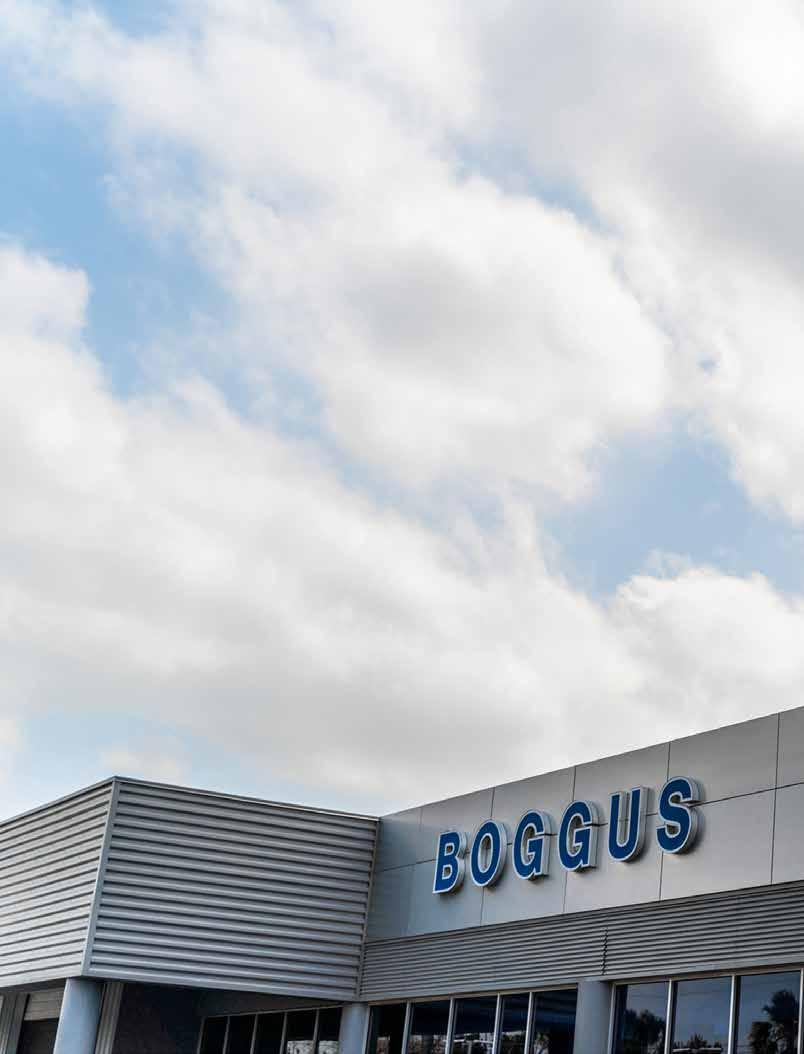
and customers as family. “It’s better at Boggus Ford, because this is a family-owned business that is always taking care of its employees and customers,” Lucio said. “As an employee, we always give 100% and this company is always giving back to the community. Mr. Boggus is always giving back to the community — it’s his way of helping others and it’s what he was taught to do.”
Bob Boggus is an active member of the community and has served in various positions, such as chairman of McAllen Chamber of Commerce. He also promotes education by providing annual scholarships and has been recognized as McAllen’s Man of the Year due to his hard work and dedication to the region — and support of nonprofit organizations.
“Mr. Boggus is always giving back to the community,” Lucio said. “He doesn’t expect any recognition — it is always better to give from the heart. Many people don’t know, but Mr. Boggus is always helping his community. He does it because he likes helping.”
Lucio, who has been employed at Boggus Ford since
“As an employee, we always give 100% and this company is always giving back to the community."
Robert Lucio, general manager
28 BUSINESS RGVISION MAGAZINE . JUL/AUG 2021
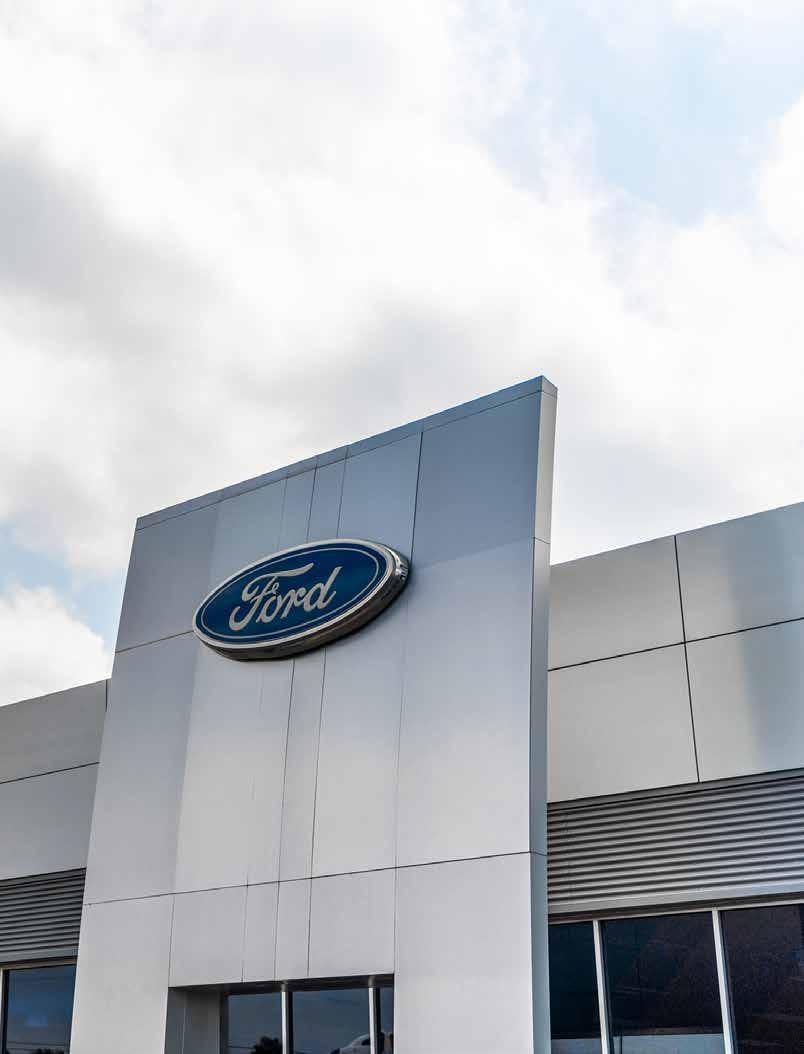
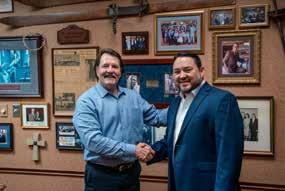
the fall of 2019, says he is proud to belong to such a company.
“At Boggus Ford, we always give the customer the best value for their money,” he said.
However, the business suffered alongside other companies in the RGV during the pandemic.
“Boggus Ford suffered this past year just like many other businesses,” Lucio said. “We had to downsize due

to our vehicle shortages. We didn’t want to cut back our employees, but it was necessary. We kept working hard and at the end, it paid off: We were able to bring back our employees and we continue to take care of customers and our families.
“Mr. Boggus has taught us that we should never put profit before people. His humanity and humility is what helps us to always give 100%.”
29 RGVISION MAGAZINE . JUL/AUG 2021 BUSINESS
GETTING TO KNOW FURNITURE
Lacks Expert Explains Stylizing One's Home
by Steven Hughes | photos by Waldo Palomares
Whenever you enter a home, what would catch your attention? Perhaps it is the furniture occupying the space. Just like there are hundreds of personalities, how one decorates their home is unique. Traditional, rustic, glam, and modern are some of the many home furniture styles one can find inspiration from.
To further explain this, Olga Maldonado, a display manager at Lacks, spoke about shopping for furniture and current trends.

How do you approach decorating a new space?
Maldonado: “Well, figuring out how to decorate, organize and add style can be a challenge. But overall, my objective is to be able to inspire and help create something that attracts our customers. First, I look at the new space, get inspired to create the room setting, imagine what it can look like and make it happen. [I] look for a focal point and start designing. It can take different [shapes] until you are completely satisfied with what you created. With
30 BUSINESS RGVISION MAGAZINE . JUL/AUG 2021
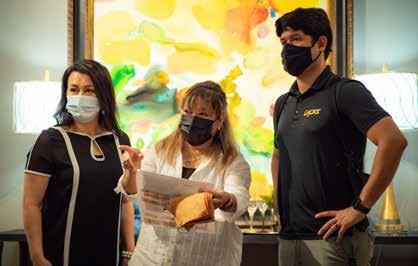

“I suggest starting by furnishing the most important rooms first. Identify the rooms you will probably spend most time in and the ones that will give the first impression to people walking in."
Olga Maldonado, Lacks display manager
the right interior design vision, furnishings, wall color, and decoration, your empty space can change from dull to exciting.”
Lacks offers many styles of furniture and accessories. Where do you get inspiration to make the store look beautiful?
Maldonado: “Decorating is much like fashion; you dress up and accessorize with the right earrings and shoes. With so many beautiful furniture and accessories, Lacks makes it easy to design. You can take any room, accessorize it, and give it a personal touch. For example, when the living room is set up, we include tables, lamps, a rug, and a picture frame or mirror. We include color, if needed, with throw pillows and greenery. If you have a large space, you can include a fireplace and an accent chair. Always accessorize in proportion and coordination with the furniture. And always keep in mind we don’t want to overcrowd a room with too many accessories. Give your home the style [aesthetic] you are trying to achieve and transform your room into a beautiful space.”
What accessories/accents do you count on to really bring a room together/make it look polished and why?
Maldonado: “Accessories like rugs, lamps, florals, and fireplaces define your space and make it interesting. [To] make a room look polished, all the furniture and accessories must tie together. This will feel balanced and will satisfy a
sense of order while making your house feel like a home. My personal go-to accessory would be a mirror and a rug. A mirror will always make a room look bigger and [it] can be accompanied by a picture frame and/or artwork. A rug will define your area or unify the furniture.”
What advice would you give someone who is furnishing a new house?
Maldonado: “I suggest starting by furnishing the most important rooms first. Identify the rooms you will probably spend most time in and the ones that will give the first impression to people walking in. Choose your furniture by determining what you love. Consider size, comfort, and style. And accessorize! Small additions can make a huge difference in your home, making it cozy and interesting.”
What is your favorite home furniture trend of 2021 and why?
Maldonado: “My favorite home furniture trend of 2021 would probably be [the] Scandinavian style. I like the raw woods and stone tops. It has a warm [and] modern [look] with a blend of textures. It is functional, beautiful, and can work with different colors from natural to blues, whites, and blacks. But overall, the furniture at Lacks can [supply] any style for all different people. You can find rustic, traditional, industrial, transitional, and glam, to mention a few. Lacks is perfect for individuals with different style preferences.”
31 RGVISION MAGAZINE . JUL/AUG 2021 BUSINESS

BUSINESS 32 RGVISION MAGAZINE . JUL/AUG 2021
PIZZA CHANGING THE COMMUNITY
Unrivaled Experience at Pieology Pizzeria
 by
by
Pieology Pizzeria is turning the idea of 'a slice and a pint' on its head, and we couldn't be happier! The Pieology Pizzeria located in Edinburg, McAllen, and soon in Cameron County offers extraordinarily healthy options for what is generally thought of as a less-thanhealthy food, making it possible for all to enjoy this American staple.
Three years ago, when the owners of Pieology Pizza decided to open restaurants in the Valley, they knew they were bringing in a new concept with the introduction of 'build your own pizza.' Initially, they were met with resistance because no other brick-oven pizzeria offered anything like it. But they persisted, and now Pieology owns the pie in this niche market.
"You need to have a burn in your belly and discipline to start a business that hasn't been already proven to work," one of the owners explained. "Now we feel proud that we jumped into the water and discovered something so successful."
This accomplishment is heightened when the owners reflect on how the staff interacts with the guests. We interviewed several management teams, and they all agree that making guest connections when personalizing the pizzas is the best part of their job. "Every day is something new, and that is because of the guests we spend time with." In addition, pieology staff really help bring people and families together through their mutual love of food.
The management team has taken this to heart. They were told, "we are in the hospitality business. You need to have a hospitality heart.' This plays out every day with the idea leaving every guest to think, 'Wow! It's like I have been invited to their house to eat.' We're not just giving our guests a pizza."
Victor Mora, General Manager, agrees that eating at Pieology is an unparalleled experience. The staff and leadership team consistently strive to create impeccable service. "We're not just in the pizza business. We're in the people business."
Pieology has also embraced supporting the local community; for example, fifty percent of their drafts are from local breweries. A Pieology employee explained, "We always use local vendors first; dealers and merchants from central Texas to the Valley." As a result, the restaurant sources all pizza ingredients regionally. In addition, it provides 50% of our local craft beer, from the 5x5 Brewing Company and Big River Brewery. Guests of

 Sofia Aleman and Cori Smelker | photos by Mark Puente and provided
Sofia Aleman and Cori Smelker | photos by Mark Puente and provided
BUSINESS 33 RGVISION MAGAZINE . JUL/AUG 2021



all ages are welcome. The kids are actively encouraged to create their own pizzas, and kid-friendly activities are available.
As the assistant manager described the ethos of Pieology and its practical application to the Valley, the passion in her voice was evident. "We believe in helping the community, so we have held fundraisers for specific events. For example, during the pandemic, we ensured our guests and our staff were always safe, and we exceeded the health standards set for us."
During the beginning of COVID-19 quarantine last year, Pieology implemented a new phone service for curbside service and introduced delivery. They quickly adapted to the changes and became the backbone of people's dinner tables when food couldn't be found at the grocery stores.
"We never seriously entertained the notion of quitting, even though it was a terrible situation," the owners explained. "We even decided to open a second restaurant (the one in McAllen) because we wanted to show the community we are here for the long run."
This was put to the test this February during the Texas freeze and power crisis that affected the entire state. Pieology never lost power, so opened their doors, allowing guests to use their location as a shelter and charging station.
Pieology operates under a core principle called "LEG UP," an acronym that entails a charitable view of helping others whenever possible.
"L" stands for local impact, including Pieology supporting the community and offering the freshest ingredients by only buying local produce.
"E" stands for an exceptional quality experience.
This means that hospitality at Pieology is, without doubt, the most essential aspect of their business model. This is not lost on the leadership and management team. Mora said these values were significant to him as he was growing up. "My family always brings a lot of food to the table and never lets anybody get up because they're serving them," he said. "So, when I came to this restaurant, and I was able to provide that kind of service and 'be myself,' not just be a corporate robot, but actually come out here and talk to people … I'm very passionate about that."
34 BUSINESS RGVISION MAGAZINE . JUL/AUG 2021

“It's important to have pride in our community. Everything we create and everything that we have around us is literally who we are. You have to help your neighbor.”
Victor Mora, general manager
"G" stands for Gratitude – the staff at Pieology are grateful for the opportunity to serve their guests and one another.
"U" stands for an unrivaled experience, and: "P" stands for being "passionate about people" and having "pride" in your community.
"It's important to have pride in our community. Everything we create and everything that we have around us is literally who we are. You have to help your neighbor," Mora said. "You don't have to change the world, but you can change everything around you. Have a great attitude, be grateful and humble, and start making a difference in the lives of people around you. That spreads like a virus — a better virus than the one we have going on right now."
Part of the business model includes creating an atmosphere where it's great to eat and fun to work. The owners always maintained a healthy work culture; as Mora explains, "Pieology is pizza and community, and it needs to be fun. A huge part of operating this successful establishment includes employees feeling like work isn't actually 'work.'"
As the membership team said, "It's about the process. We need to enjoy the process and have fun. We should appreciate the position we are running, then the outcome will be great because we are not focused on the finish line."
A tenet of the company is "There are no funds without fun." In other words, a person can work hard, connect, and have all expectations met, but if they are not enjoying their work, it won't last. At Pieology, management and employees need to enjoy their jobs and grow with the
company. As a result, Pieology employees are not just trained in their position; they are also actively mentored and guided by the leadership team. The expectation is that the leadership team will care personally for the staff and consistently demonstrate compassion. This, in turn, ignites a sense of togetherness and ensures every employee feels confident in their role. In addition, the culture instilled by the owners has provided opportunities to team members who started with them, earning leadership roles in the business today.
"You know, the owners here have definitely taken me under their wing. They've taught me a lot, and I've expanded and grown with them, and I always appreciate it," Mora said. "I'm very grateful for the opportunity that they've given me by bringing me into this restaurant."
Pieology's tagline is, "Bring your imagination, we will take care of the rest." This applies obviously to the unique pizza experience, but it permeates every part of the company. Through supporting the community, uplifting their employees, and putting the guest first, Pieology has made a lasting impact and created deep roots.
As the owners of these Pieology locations say, "Success comes from making these persistent efforts every day."

35 RGVISION MAGAZINE . JUL/AUG 2021 BUSINESS


STOP LAWSUIT ABUSE
Texans Depend on Commercial Vehicles — Let’s Protect Owners, Operators From Frivolous Lawsuits
by Sergio Contreras and Sarah Sagredo-Hammond
Next time you drive down the road, take a look at the vehicles in the lanes next to you.
You may see a plumber in a pickup truck. You may see a delivery van for a brewery or a bakery, dropping off products at a restaurant. You may see a pharmacy worker delivering prescriptions, a local realtor on the way to a home showing, or a rideshare service making a drop-off in a sedan or SUV.
All of these are commercial or company vehicles. All of these are critical to our communities. And all of them are a target for frivolous lawsuits.
When you think of commercial vehicles, you may automatically think of the big trucks and 18-wheelers we see on the highways. Some personal injury lawyers have aggressively made these types of accidents the center of their practice. But now, any truck or car with a company’s logo on it is a target.
With automobile-related lawsuits up 118% from fiscal year 2008 to fiscal year 2019, it’s clear there is a problem. In 2019, 1 out of every 10 accidents resulted in a lawsuit — that’s up 71% from 2008. We’re not seeing a correlation between increases in our state’s population (20%), crash fatalities (5%) or crash injuries (2.5%). Other types of personal injury lawsuits even decreased 7% over that time period. Something just isn’t right.
Many of these company vehicles are operated by small businesses. Today, nearly 90% of all commercial vehicle companies in Texas operate 10 or fewer vehicles. And these small businesses are feeling the pain.
Insurers are raising rates for coverage in Texas because of the heightened liability environment. That puts serious financial pressure on Texas employers, who either have to absorb the cost of increased insurance or pass the cost along to their customers. In the worst cases, some even
have to close their doors because they simply can’t keep up with the increase in insurance rates.
They aren’t the only ones who will struggle. If the Texas Legislature doesn’t act quickly to shut down this lawsuit abuse, it won’t be long before it starts affecting all of our pocketbooks — from the price of groceries and gas to the cost of home maintenance services and shipping on our packages.
No one wants to see an accident and we all want to see bad actors held responsible. If a commercial vehicle is responsible for an accident, they should be held accountable. At the same time, we depend on commercial vehicles operating safely every day, and they can’t continue to do so without fear of a lawsuit.
The Texas Legislature is considering reforms that clarify the rules for how these lawsuits are handled and ensure juries have the facts needed to award fair verdicts. House Bill 19 by Rep. Jeff Leach of Plano and sponsored by numerous members of the Legislature, including Sen. Larry Taylor of Friendswood, Sen. Eddie Lucio Jr. of Brownsville, Sen. Juan “Chuy” Hinojosa of McAllen, and Rep. Eddie Lucio III of Brownsville, will help achieve this critical balance.
Abusive lawsuits against the owners and operators of commercial vehicles continues to be a serious problem. Texas lawmakers should rein in these types of lawsuits that are driven more by greed than justice or safety.
EDITOR’S NOTE: House Bill 19 was pending final approval as this edition of RGVision Magazine went to press.
Sergio Contreras is president and CEO of Rio Grande Valley Citizens Against Lawsuit Abuse. Learn more at www.rgvcala.com.
Sarah Sagredo-Hammond is president of Atlas Electrical, Air Conditioning, Refrigeration, & Plumbing Services
ARTICLE PROVIDED BY Sergio Contreras President/CEO RGV Partnership
36 BUSINESS RGVISION MAGAZINE . JUL/AUG 2021

JULIAN ALVAREZ
RGV’s Jobs Guru Sees Promising Economic Recovery in Post-COVID-19 Future
by Bryan Kirk | photos provided
After more than a year of mask mandates, government quarantines, and widespread unemployment, there is light at the end of the tunnel for the South Texas labor force.
Texans who were laid off or furloughed from their jobs, and forced to live off the occasional government stimulus check, unemployment, or the Pandemic Emergency Unemployment Compensation Program as a result of the novel coronavirus outbreak, have slowly been returning to work.
Julian Alvarez, who grew up in Harlingen, has served as the Texas Workforce commissioner for labor, representing the interests of more than 14 million working Texans since his appointment in 2016, and he sees a lot of promise for the South Texas region.
“My job here at the Texas Workforce Commission is to make sure we have the skilled workers for in-demand occupations,” he said.
Alvarez said that while jobs in the service industries such as restaurants, hospitality occupations, and retailers were among the hardest hit, educators were among the most numerous filers for unemployment in Texas during the health crisis.
However, Alvarez said those jobs are coming back strong with the reopening of the state’s economy, with many offering signing bonuses or slightly higher wages than before the coronavirus outbreak.
These service industry jobs are also
being spurred by the growth of other industry sectors, such as the tech industry, health care, and aerospace, which are offering higher paying wages.
Even in the months before COVID-19, the South Texas region was beginning to emerge as an attractive market for hightech industry occupations in education, health care, logistics, and aerospace.
Much of that is a result of new growth — and grant partnerships with schools and employers to provide up-skill training to new or current employees.
“There were many different reasons why people were not returning to work right away. It wasn’t just because they were receiving their PEU benefits. It’s other things,” Alvarez said. “It could be that we did a really good job of re-skilling and re-tooling these individuals.”
Alvarez said there were probably instances of employees who were working as hotel maids before the pandemic who’d been laid off and used this time to obtain a new skill and retrain, such as coding or in cybersecurity.
Much of the training was offered by the Texas Workforce Center at local community colleges, or online through the METRIX program linked to the WorkInTexas. com website.
At the height of the pandemic, displaced workers were advised by the Texas Workforce Centers in their area to use these
free METRIX learning services to add new occupational skills badges that could help to new and promising careers.
“This has been very successful,” Alvarez said. “Thousands have gone through this program, at no expense to them, and we are continuing this because of its success.”
However, Alvarez says retraining and upskilling the Rio Grande Valley workforce is only part of the process. The other part of the Valley’s brighter economic future are the types of jobs that have emerged after several years of grant funding to create a high-tech workforce.
For instance, the Mission Economic Development Commission worked collaboratively with the TWC to launch a $150,000 high-tech boot camp to train individuals interested in cybersecurity careers, all of which was made possible using a $75,000 High-Demand Job Training grant from the TWC.
“It’s interesting that many of those people who completed this program are not working for municipalities, for banks and healthcare institutions, so it’s amazing what they are doing,” Alvarez said.
There is also a critical need for registered nurses in the Valley. Alvarez revealed that the TWC was working in partnership with Doctors Hospital at Renaissance on a skills development grant program that will train physician’s assistants in a specific medical specialty, such as wound care, internal medicine, or mental health.
“No one else in the country is doing anything like this,” he said. “PAs graduate with a PA degree, but they don’t go into any specific medical specialty. DHR is going to train these individuals — with our help — to serve in a specific healthcare department. This is amazing.”
In high-tech news, Tesla is looking to hire skilled employees at its Brownsville Service Center after they receive the necessary training at Texas State Technical College in Harlingen and nearby community colleges.
Meanwhile, SpaceX, which has its launch site in Boca Chica, is also looking to hire skilled workers, such as welders, aerospace engineers, mathematicians, and technicians. Alvarez said SpaceX has discussed developing their own local pool of talent with his office and local
38 BUSINESS RGVISION MAGAZINE . JUL/AUG 2021

school districts.
“These careers are going to be out there,” he said. “These companies are hiring local talent. They are picking the best of the best.”
Training in these new careers is happening thanks to the $16 million Jobs and Education for Texas grant (JET) program from the TWC, which pays for the technical equipment needed to train and certify employees for better paying jobs.
“Some of the smartest people are from the Valley, and they are going to stay there,” he said. “We are growing our own doctors, we are interviewing our doctors that are going to stay here, and we are creating slots for our doctors. I think that is what you are going to see here with SpaceX and other high-tech companies.”
So, what happens next?
Creating a better quality of life for the young adults from the Valley, who are graduating from high school and college is critical, Alvarez says.
That begins with providing access to these job training skills, and job training certification in high-tech careers that fosters and maintains a home-grown workforce.
In some respects, Alvarez believes there is already a big economic development and cultural shift underway in the Valley, and that it is a shift driven by companies like SpaceX and Doctors Hospital at Renaissance, which will attract more hightech companies to South Texas in the notso-distant future.
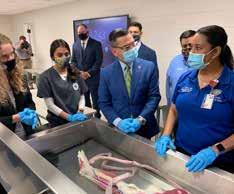
“Young kids are seeing these changes happening right now in front of them,” he said. “How amazing is it that kids in South Texas can see a rocket launch from their backyard? That just makes things possible. If you can see yourself being a physicist or an aerospace engineer, then you will probably be able to do it.”
39 RGVISION MAGAZINE . JUL/AUG 2021 BUSINESS

40 BUSINESS RGVISION MAGAZINE . JUL/AUG 2021
LA JEFA
A Woman of Many Hats
Local Businesswoman Maritza Esqueda Discusses Career Journey
by Elisa Garcia | photo by Barbara Delgado
Not many 23-year-olds would imagine running their own business, but for Maritza Esqueda, this became a reality when she founded Forum Records Management in 2003, a full service records and data management company based in Mission. Over the past 21 years in the industry, Esqueda is now the COO and managing partner of Lone Star Shredding, co-founder and president of Greater Gold Foundation, and the co-founder and owner of beauty salon Mane on Main Street.
Having studied International Business at the University of Texas at San Antonio, Esqueda said she always knew she wanted to be a businesswoman.
“I have always loved the idea of starting and growing your own business. I was always fascinated by it. I admired and emulated successful women, they had this freedom in their careers, they could be moms, they could be businesswomen, and they could be the boss,” she said. “I always knew that I wanted to work for myself, and I wanted the freedom to have it all.”
Although Esqueda wears many different hats, she explained her true passion lies with her work at the Greater Gold Foundation (GGF), a nonprofit that financially aids families who have a child diagnosed with cancer. Her work with childhood cancer has earned her various recognitions, such as Sharyland ISD Education

Foundation’s 2018 Woman of the Year, Vannie E. Cook Children’s Cancer Center’s 2017 Community Hero, and City of Mission’s 2014 Woman of the Year.
Founded in 2009 under the name FaithFamily-Friends Foundation by Esqueda and Eddie Vela, who passed away in 2010 from appendix cancer, Esqueda continued their mission of raising funds for those diagnosed with cancer in the Rio Grande Valley. However, five years into this specific type of work, Esqueda received an application for assistance for a child named Jesse. It led to her researching childhood cancer and creating the Greater Gold Foundation.
“When getting to know more about (childhood cancer) I visited Vannie E. Cook because I just wanted to know (more),” she said. “What I found was that childhood cancer isn't rare. There are hundreds of kids in the Valley who are battling cancer every day. Jesse passed away soon after I met him, but he inspired me to advocate for children, for research, for a cure, for what I would define as my true purpose; my real purpose in life, me as an individual. It was presented to me, and I do not think it was by chance, I decided that childhood cancer was something that I needed to advocate and create awareness for.”
Today, in addition to providing financial assistance in the form of medical bills,
41 RGVISION MAGAZINE . JUL/AUG 2021 BUSINESS
“I have always loved the idea of starting and growing your own business. I was always fascinated by it. I admired and emulated successful women, they had this freedom in their careers, they could be moms, they could be businesswomen, and they could be the boss. I always knew that I wanted to work for myself, and I wanted the freedom to have it all.”
Maritza Esqueda
COO and managing partner at Lonestar Shredding and Document Storage
travel expenses, living expenses, etc. GGF also spreads awareness for childhood cancer. According to their website, during September, Childhood Cancer Awareness Month, they participate in parades, walks, billboards, and Friday Night Light Events.
On top of being a mother, Esqueda’s most significant accomplishment is the impact GGF has contributed to the community. In 2019, GGF collaborated with 28 South Texas high school football teams, volleyball teams, cheer squads and schools to wear gold wristbands in recognition of children battling cancer in the area. In total, their efforts had over 6,000 students wearing gold wristbands during the month of September, bringing awareness to this special cause. "This has been amazing to witness, only 7 short years ago, I had to purchase wristbands myself and convince kids to wear them, our first year there were only 400 players who participated.", she said.
“My perspective on life has changed so much based on the kids that I get to meet and the parents who share their kids’ lives with me,” she said. “To watch kids fight for their lives, their resiliency, their smiles, the small and large triumphs, and the kind of sacrifice parents have to make, it has in a way changed my DNA. I try not to complain much, I have so much appreciation, for the little things. To me, if I wake up and my kids are healthy, I have so much to be grateful for.”
One dream Esqueda would like to make a reality in future is to open a hospice home for children.
“I want a hospice home for children that's like a farm, or a petting zoo, where kids can look out the window and find joy in nature and animals in their view. I've been in the room with several kids who are passing and I feel like this environment could give them a sense of peace as they're transitioning from their disease into what happens next,” she explained.
Even while leading three businesses, Esqueda said she has the freedom in her career to be a mom first. Although not always easy, she continues to lead from the front by putting her team members first.
“(Being a leader) in my experience is having done everything that you ask other people to do,” she said. I think an important trait of a leader is having the ability to say, ‘Hey, I'm asking you to do it, but I've done it before, and if you need to, I’ll do it with you again. ’Ive driven the trucks, shredded the paper, put up the racks, pulled the boxes and for me, it has created a culture of loyalty in my businesses that I don't think I could replicate. I like to believe it comes from leading from the front, not leading from the top.”
Esqueda’s latest career accomplishment was being elected as a school board member of Sharyland ISD. Out of the board’s seven members, Esqueda is the only woman at the table.
“I'm super excited to have a seat at the table, to be able to participate in making decisions that both impact and steer the education of children in my community,” she said. “As women, as mothers, I believe we have a maternal instinct that gives us unique perspectives. I strongly believe that anywhere decisions are being made for children, women should be involved.”
For future young women who aim to become a CEO or business owner, Esqueda said she believes representation is important for young ladies to see someone who looks like them, representing them as decision makers and leaders .
“If you're lucky enough to find your purpose, whatever it is, just follow your purpose. Put everything in it,” she said. “I always advise that being generally generous is great, but if you find your true purpose or true passion, just double down, give all of yourself to this one thing, your impact will be greater than you can imagine. That's what's worked for me.”
42 BUSINESS RGVISION MAGAZINE . JUL/AUG 2021

FRANKE REALTY
South Padre Island’s Stagnant Commercial Real Estate Market Becoming More Robust Going into 2022
by Bryan Kirk | photos by James Hord
The economic stagnation that has apparently gripped the South Padre Island real estate market for a little more than a decade is slowly showing signs of new life in 2021 and beyond.
Dennis Franke, who heads up one of the oldest and most well-known real estate firms on the island, said SPI’s real estate industry has been “fairly flat” since the start of the Obama Administration — during what many economic experts called the Great Recession.
“That administration literally sucked all the optimism and energy out of the economy. When you take the optimism out of the markets, the first thing to go are luxury items and the last thing to come back are luxury items,” he said. “It’s been a very long downturn with very little going on, but we’ve gone through this period, and we are back in the groove where things are going good.”
Franke Realty, which has been instrumental in the development of South Padre Island for more than six decades, has a reputation of providing quality professional services related to vacation condominium rentals and other luxury real estate needs.
Franke said despite the long downtown, the desire for luxury rental properties has been consistent, and it has had the South Padre Island market hovering in place for quite some time.
“We’ve only recently begun to see a serious uptick in the interest of real estate here on the island,” Franke said. “We are in a luxury market. We sell luxury real estate that people don’t have to have, but they do want.”
One of Franke Realty’s most popular developments is The Shores, located
in the north end of South Padre Island between the Gulf and Laguna Madre. The luxury seaside community includes an equestrian center, parks, shops, a marina, and world-class hotel amenities, according to its website.
All of these amenities encapsulate and promote the walkable concept of liveable communities, which has become more common in densely urban areas.
Many of Franke Realty’s customers who long for luxury come from here in Texas — and Monterrey, Mexico, which Franke adds has recently begun to come back into the market.
Other factors affecting the change is the recent absorption of real estate properties that Franke called “distressed.”
Those distressed properties had apparently accumulated over many years, and were considered an eyesore to the South Padre Island community.
This liquidation began with the selling off of some of the least expensive distressed properties.
Franke suspects that as those properties sold, it gave incentive for buyers to swoop in and buy up others that helped foster a sustained market increase.
“This is a very positive sign, because until you liquidate those properties and an owner is willing to lower the price in order to sell it off, you cannot stabilize the commercial real estate market,” he said. “At this point, it has stabilized — probably a year ago — and from that point forward, has gotten consistently better.”
Franke said the market has improved

44 BUSINESS RGVISION MAGAZINE . JUL/AUG 2021

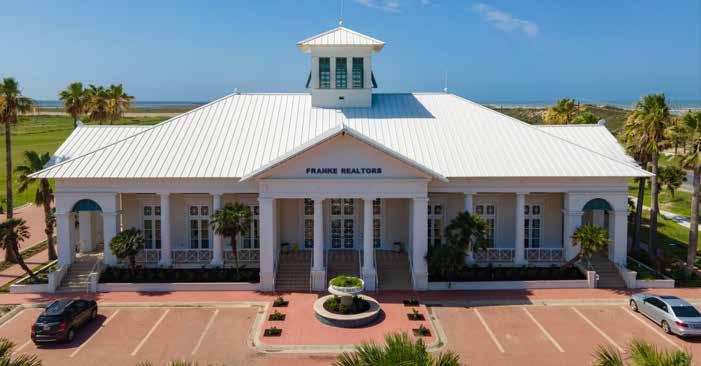
45 RGVISION MAGAZINE . JUL/AUG 2021 BUSINESS
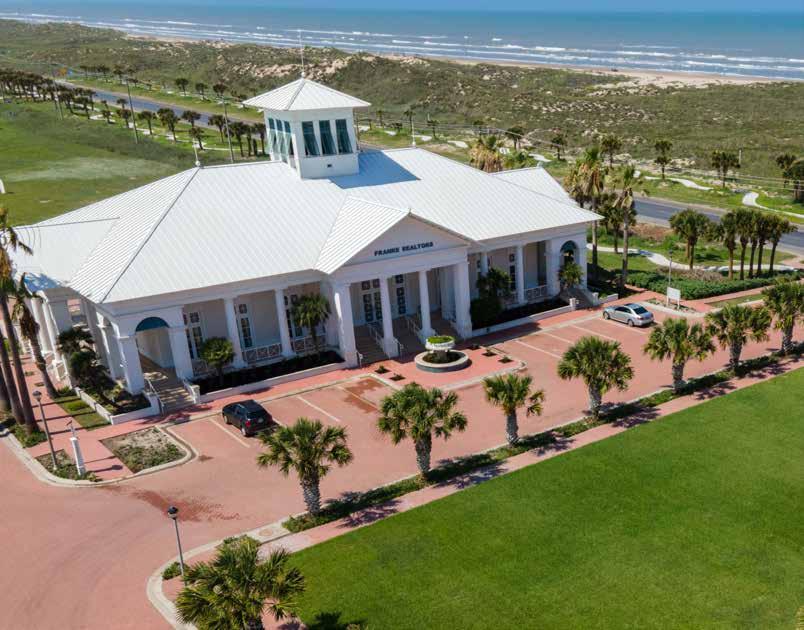

46 BUSINESS RGVISION MAGAZINE . JUL/AUG 2021


“I look forward to this market continuing and would think that as the year progresses and as we move into the summer, the market will do nothing butprove.”
Dennis Franke, Franke Realty
to a point where the distressed properties are nearly all gone, real estate inventories are down, new properties are coming on the market, and market prices are stabilizing and beginning to appreciate.
According to movoto.com — an online real estate database that lists available properties in the U.S. — the local real estate market began to slowly increase in 2020 and jumped sharply with the average list prices increasing from $649,000 on Feb. 1 to about $1.5 million by March 1.
By the same token, local tourism may have also been impacted over the same span of time. According to the 2019 South Padre Island Resort market analysis from the South Padre Island Economic Development Corporation, the statistics indicated a steady increase in traffic across the Queen Isabella Causeway from 1990 to 2007.
However the same statistics inculcate a decrease in traffic in 2008, which was attributed to Hurricane Dolly, and fluctuated between 2008 to 2018, because of economic uncertainty.
The report also indicates that between 2010 and 2013, during the Obama Administration's recession recovery, hotel revenues on the island increased only slightly, and were far behind the markets at Corpus Christi and Galveston.
A majority of the island’s visitors have traditionally traveled from Mexico, and accordingly represent a significant revenue generator for South Padre Island’s tourism industry.
Although the report was produced prior to the COVID-19 outbreak, the information suggests an upward trend in tourism through
2019 and beyond.
More good news followed in May 2020, when the EDC — amid the pandemic — released its Opportunity Zone Investment Prospectus that highlighted some of the potential areas of investment, and the potential for greater economic growth from industries such as SpaceX.
The report also showcased the magnificent beauty of the island’s beaches — which are among the cleanest in Texas — the abundance of wildlife, tremendous number of recreational opportunities available, and natural resources.
“This is a very positive time for the island; a more positive time than we have had in several years,” Franke said. “I look forward to this market continuing and would think that as the year progresses and as we move into the summer, the market will do nothing but improve.”
While Franke expects the rest of 2021 to be a good year for real estate, there are caveats for the future that may hinge on what the Biden Administration does in the areas of taxation — and the possible impact increases would have on the markets.
Despite those concerns, Franke remains optimistic that the South Padre Island market will experience a long streak of sustained and positive growth going into 2022.
“I think almost everybody, not everybody, but almost everybody, are just over it. People are sick of thinking about the coronavirus, and they are sick of wearing a mask,” he said. “Most people have been vaccinated and want to get back to normal activities. There’s no reason that we need to continue down the same path, and people are ready to get back out, go on vacation, and travel.”
47 RGVISION MAGAZINE . JUL/AUG 2021 BUSINESS
STIMULUS CHECKS
Local Business Leaders See Positive and Negative Impact on Local Economy
by Bryan Kirk
It’s been more than a year since the world first heard about the mysterious virus known as COVID-19, and more than a year since American workers first began to receive government checks in the mail after businesses were forced to close — and everyone deemed nonessential were furloughed or laid off.
The deadly virus, which reared its head in December 2019 in Wuhan, China, and quickly spread worldwide, killed thousands in just a few weeks. Governments issued warnings and took drastic action that included quarantines and shutdowns.
The U.S. was among those governments that closed federal facilities, while state governors followed suit by shutting down state and local government offices, schools, and businesses, sending American workers into quarantine. It didn’t take long for many to realize that the health crisis had slammed the brakes on the booming U.S. economy and created a substantial economic crisis.
Congressional leaders when to work, and in March 2020, then-President Donald Trump signed the $2.2 trillion Coronavirus Aid, Relief, and Economic Security Act, which added billions toward pandemic relief for those who’d lost their jobs and guaranteed millions of Americans would receive a $1,200 stimulus payment to be used toward essential goods.
It would be the first of three stimulus packages congressional leaders would pass, with the last in March 2021 signed into law by President Joe Biden.
The initial rounds of stimulus payments were a welcome sight to many displaced workers, but overall these payments may act as a double-edged sword.
“I think the stimulus payments helped people from a financial standpoint, but the challenge from an employer’s standpoint is that they’ve had trouble getting people to come back to work,” says Raleigh Taylor, who serves as a special advisor with the U.S. Chamber of Commerce in Washington, D.C. “This ends up impacting people adversely, because if businesses aren’t able to operate and operate at the capacity they are used to, then they have to start laying
off and restructuring. In the long term, I think it’s adverse in a macro side effect.”
According to data from the Texas Comptroller’s Office, the 28-county South Texas region, which includes Laredo, Corpus Christi, and the Rio Grande Valley, was beginning to see the benefits of a slowly growing population in some counties, increases in college enrollment, and economic growth in 2019.
However, much of the positives seen in the dawn of a new decade seemingly evaporated overnight. Restaurants and hotels closed in the middle of spring break — a peak season for South Padre Island and Corpus Christi — and grocery stores saw runs on cleaning supplies, toilet paper, and non-perishable foods.
Business segments such as restaurants and retailers were among the hardest hit by the crisis, but so were industries like oil and gas, which saw the price of oil drop to near zero last summer.
Sergio Contreras, president and CEO of the Rio Grande Valley Partnership, said the stimulus overall had been beneficial to the local economy, but there continues to be hardships to some local businesses.
“There are certain industries that are struggling to get the workforce that is needed to sustain and maintain their business as the economy begins to open,” he said.
Like Taylor, Contreras agreed that the retail and restaurant industries were among the hardest hit that continue to struggle, as well as the construction industry.
“There are multiple reasons,” he said. “Either they have not been vaccinated or don’t plan to get vaccinated, so there is that fear.”
Contreras added that some workers are not working because receiving unemployment benefits outweighs going back to work, while other workers are concerned about the availability of training to obtain a skill.
Mike Gonzalez, communications specialist for the Lower Rio Grande Valley’s Workforce Solutions Office, said while the stimulus payments were helpful, the Federal Pandemic Emergency Unemployment Compensation Program, which


48 BUSINESS RGVISION MAGAZINE . JUL/AUG 2021

was initially enacted under the CARES Act in 2020, probably helped more. And while employers in nearly every sector suffered, things are starting to turn around.
“We are seeing the market repair itself, and in essence we are seeing employers offering higher pay rates to make themselves more competitive in the job market, because as it stands right now, we have more jobs available in Texas now than we did prior to the pandemic,” Gonzalez said.
Juan Garza, who owns and operates Pieology Pizzeria franchises in McAllen and Edinburg, is like many other small business owners who’ve lived the struggle of trying to keep his workforce intact and his business afloat during a global pandemic.
Before the start of the pandemic, Garza had 50 employees. But as news spread that whole economies would close down, staff at his store locations were fearful of losing their jobs.
Garza said he promised his staff members that they would all keep their jobs and be able to keep working, but that hours would be significantly reduced.
Initially, everyone accepted what was happening, but when the federal government authorized pandemic relief payments and unemployment insurance for displaced workers, half of his employees stopped coming to work.
“People aren’t unable to work, they are unwilling to work,” he said. “This was a totally new animal. No one thought this would happen this way.”
Garza, who came to the U.S. from Mexico in 2008, said the initial pandemic relief packages were helpful, but added that the pandemic relief and subsequent stimulus payments had the same effect on his workforce as it has for decades for citizens in Mexico.
“In Mexico, we are used to getting help from the government for everything,” he said. “The moment you start subsidizing people who are lazy, people who won’t work, or people who won’t go to school, you start creating little monsters, and they get used to not doing anything.”
While most would consider this catastrophic, Garza said the actions of those employees who left was a silver lining, revealing to him who his best and most reliable employees really were. Many of them have since received raises of up to 30%. As people slowly begin to return to work, Garza said he doesn’t hold any hard feelings to those employees who quit, and would hire them back if they asked for a job.
“I believe in second chances,” he said. “This country is a wonderful place of opportunity, and you have to be able to give people a chance to do better.”


THE RESULTS YOU WANT. THE CARE YOU DESERVE.
DPTSI is your RGV 1-STOP-SHOP for Rehab, Fitness, Wellness & Homecare. Our Physical Therapy staff at DPTSI, DPTSI FIT, DPTSI SPA & DORADO are here for all your physical therapy and wellness needs.
5216 S. Jackson Rd Edinburg, TX 78539

DPTSI FIT specializes in the guidance and training of purpose driven exercise for optimal functional results.
9120 N. 23rd McAllen, TX 78504

Come experience the tranquility of a DPTSI SPA Massage to emerge back to the world calm & invigorated.
5216 S. Jackson Rd Edinburg, TX 78539

(956) 205-2704
WWW.DPTSI.ORG Drs. Andre and Anessa Acuña
49 RGVISION MAGAZINE . JUL/AUG 2021 BUSINESS
LGBTQ+
MENTAL HEALTH AWARENESS
For many, June may seem like just another month, but for the LGBTQ+ community, it symbolizes justice and equal opportunity. Pride Month is celebrated each year in June to honor the 1969 a uprising, but it also provides an opportunity to organize peaceful demonstrations, raise political awareness, and confront current issues of discrimination and injustice plaguing society today. Current research points out that discrimination, poor mental health, and societal stigma are common factors contributing to health disparities among the LGBTQ+ community.
STIGMA AND DISCRIMINATION
Health disparities among LGBTQ+ individuals are significantly associated with stigma, discrimination, and violence. Sadly, LGBTQ+ youth are more likely to suffer from social inequalities, such as food insecurity, homelessness, foster care, unstable housing, and poverty, than their heterosexual and/ or cisgender peers. Similarly, older LGBTQ+ adults face additional challenges that stem from the combination of anti-LGBTQ+ stigma and ageism (APA, 2017).
MENTAL HEALTH
LGBTQ+ individuals are more than twice as likely as heterosexual individuals to suffer from a mental health disorder, including depression, anxiety, and substance use (APA, 2017). Research has revealed that such

increased risk among LGBTQ+ individuals can be attributed to the experience of ongoing stress from enduring stigma, discrimination, and violence. Indeed, research reports that, compared to their heterosexual peers, lesbian women are twice as likely to experience depression while gay men are three times as likely. Additionally, LGBTQ+ individuals are more susceptible to substance abuse. A recent study reports that lesbian and bisexual women have a higher rate of substance use of nicotine and alcohol while gay men are likely to smoke and use stimulant drugs. Mental health problems also contribute to an increased risk of suicide. Almost half of adolescent lesbian and bisexual women have attempted suicide while 3 in 10 adolescent bisexual and gay men have attempted suicide.
Even more troubling, LGBTQ+ individuals with multiple marginalized identities, such as LGBTQ BIPOC (Black, Indigenous, and people of color) or undocumented immigrants, encounter additional risks for complex experiences of oppression and trauma resulting from social and structural inequality. In addition to a higher risk for mental health problems, LGBTQ+ people have less access to healthcare and lower rates of preventive assessments for various treatable ailments. LGBTQ+ individuals are also less likely to be insured and report a greater inability to afford
50 HEALTH RGVISION MAGAZINE . JUL/AUG 2021
Research has revealed that such increased risk among LGBTQ+ individuals can be attributed to the experience of ongoing stress from enduring stigma, discrimination, and violence.
health services compared to non-LGBTQ+ counterparts.
LGBTQ+ RIGHTS
As of now, 2021 is set to become the year with the highest number of anti-transgender bills introduced. These bills include legislation on anti-trans sports (Arkansas, Mississippi, Tennessee, and Texas), genderaffirming health care for minors (Arkansas, Texas), and religious refusals (North Dakota, South Dakota, and Arkansas). Although several bills are eradicated in the committee stage, the trans community may still experience distress watching proponents argue in favor of anti-trans bills. However, at the same time, the U.S. House of Representatives voted to pass the Equality Act, a bill ensuring additional non-discriminatory protections for LGBTQ+ Americans. The bill bans discrimination based on sexual orientation and gender identity (SOGI) in employment, housing, credit, jury service, public accommodations, and federally funded programs. The Equality Act would amend the 1964 Civil Rights Act, if passed. Thus, its presence in the Senate has generated significant contention.
Systemic and social injustices persist against the LGBTQ+ community; increased barriers to mental health services are among the most prominent challenges, which signifies the need for more social action to support this community. Self-education on this issue can be a first step, followed by advocacy for public policy that addresses these challenges. Mental health professionals and the public alike can become active members of this needed force.
A MESSAGE TO TEENS AND THE COMMUNITY
During the pandemic, LBGTQ+ teens and youth were more likely to report mental health challenges, receive fewer health services, and lack social and family support. If you or a loved one identifies with this situation, you can reach out to the available local or college/university sources. Several academic and community-based centers serving the LGBTQ+ community have transitioned to online platforms to continue providing support. Some resources include:
• The Trevor Project Crisis Intervention and Suicide Prevention: 1-866-488-7386 or TrevorChat
• LGBT National Help Center: 888-843-4564
• Q Chat Space
• Tropical Texas Behavioral Health crisis hotline (available 24 hours): 877-289-7199
• U.S. Suicide Prevention Lifeline: 1-800-273-8255
(Co-authors include Dr. Mercado’s Mental Health Lab at UTRGV: Andy Torres, Maria Sevilla-Matos, Sandra Valeria Chapa, Josue Cerroblanco, Marcos Valdez, and Frances Morales.)

ARTICLE PROVIDED BY Alfonso Mercado
PH.D., Licensed Psychologist
Valley Psychological Services - Assistant Professor
Department of Psychology at the University of Texas
Rio Grande Valley | www.utpa.edu/psychology
51 RGVISION MAGAZINE . JUL/AUG 2021 HEALTH

MY FIRST RODEO
Rodeo Dental Celebrates Young First-Time Patients
by Rocio Villalobos | photos by Mark Puente
As a new parent, there are so many firsts. First word. First steps. First trip to the park. First dental visit. These types of new experiences can be intimidating for the whole family.
Being free of all fear and anxiety when it comes to dentist visits is essential to ensuring your child will have a foundation of healthy oral habits.
Dr. Violetta Chu, general dental practitioner at Rodeo Dental & Orthodontics said the first visit is crucial and can set a child on the path to maintaining good oral health into adulthood.
RGVision sat down with Dr. Chu to discuss how to prepare, practices for healthy teeth and what you can expect when you take your child for their first visit to the dentist.
When is the right time to take a child to their first dentist appointment?
Dr. Chu: “We encourage bringing your child as early as 6 months old, even if they don’t have teeth yet. Parents should definitely bring them by the time the first tooth comes in, but no later than the first birthday.”
What happens during the first visit and how often should a parent bring their child in?
Dr. Chu: “When they first get to their dental appointment, we will talk to the parent about their kid’s oral health
— habits, any hazards. Are they sucking their thumb? Grinding teeth? We do an exam to make sure everything looks good.
A dentist will let you know how frequently they recommend bringing a kid in — usually every three to six months.”
Is there anything parents can do to help prepare their child for the new experience?
Dr. Chu: “I encourage parents to brush their kid’s teeth regularly or wipe their mouth with a soft wet cloth if they don’t have teeth — something just to get milk out of gums. This helps get kids used to someone cleaning their mouth, which is going to help them be more comfortable at the dentist.”
How do the doctors help a child who’s experiencing a high level of anxiety or nervousness surrounding the visit?
Dr. Chu: “We definitely set the stage so it's an exciting fun time for a kid. To get them to be more relaxed, we would just ease them into the appointment. We tell them we are just going to tap your teeth. We make it exciting and ask questions, get them really engaged. We like to make jokes to get the kids to laugh, and then a lot of times we let them know what we are going to do and show them this is a mirror it's nothing to be afraid of — things like that. A lot of times we hand the toothbrush to the kid and ask them, ‘how do you brush your teeth?’ A lot of times they are more comfortable taking the toothbrush and showing us. Then we will be like, ‘OK, that’s awesome. Are you doing it like this?’ and we take their hand and guide them.”
What strategies do you suggest that could help a child embrace brushing their teeth and view it as less of a chore?
Dr. Chu: “There are a lot of toothbrushes that look like toys — ones that spin, some that light up. Just make it a fun time for the kids. They also have flavored toothpastes. It does not matter what kind, as long as it has fluoride. They may be excited to try the different flavors like
54 HEALTH RGVISION MAGAZINE . JUL/AUG 2021

“We’re very family driven and like to make sure the parents and the kids have fun when they’re with us. Recently, we celebrated a child’s first birthday and first dental visit with cake and balloons. With us, health and fun go hand in hand. We're not your typical dentist office.”
Dr. Violetta Chu, general dental practitioner at Rodeo Dental & Orthodontics
bubblegum, grape, or cherry. Another thing I encourage is for parents to brush their teeth in front of their kids. A lot of times, they see a parent do dishes and they want to do dishes. So, if they see their parents have very healthy dental habits – brushing, flossing — kids are going to want to do that, too.”
If a child has a sweet tooth and a parent is struggling to reduce the amount of sugar they consume, are there any alternatives to offer in place of sugar-heavy treats that they will still enjoy?
Dr. Chu: “We discourage sugary snacks and drinks like juice and soda, but if kids are already very used to it, there are certainly compromises.
If it is juice, you can start watering it down. Add water more and more each time, so eventually the drink they have is less and less sweet, then eventually it is just water. Also, it matters the time the parents are giving kids snacks and drinks. During mealtimes they can have their juice in the morning or chocolate milk with their dinner or something like that. It’s more important they have it with a meal as opposed to as a snack because the more time they're having sugary foods, they’re more likely to get cavities.”
What types of foods are best avoided and what foods promote good oral health?
Dr. Chu: “There are certainly foods that are worse for cavities — anything sweet and acidic candy-wise, like caramel and things that are sticky. That is worse than just regular candy.
On the other hand, whole grain foods — foods and vegetables with a lot of fiber — are great. These foods need more chewing and require more saliva, which will help lower the chance of cavities.”
Are children more susceptible to cavities or other dental issues? Should they be brushing more frequently than adults or engage in any other specific oral care?
Dr. Chu: “For baby teeth, because of the anatomy, cavities do get bigger faster in baby than adult teeth. But kids do not have to do anything different than adults —brushing twice a day, flossing. A lot of times flossing gets forgotten because they don’t think they need to floss yet, but as soon as teeth touch, there are gaps where food and bacteria can get trapped.”
What makes Rodeo Dental & Orthodontics different from other doctors?
Dr. Chu: “We’re very family driven and like to make sure the parents and the kids have fun when they’re with us. Recently, we celebrated a child’s first birthday and first dental visit with cake and balloons. With us, health and fun go hand in hand. We're not your typical dentist office.”
Rodeo Dental & Orthodontics offers extended hours — 10 a.m. to 7 p.m. — and has multiple locations across the Valley to accommodate a family’s schedule. Parents can also make an appointment for themselves along with their child.
To locate the Rodeo Dental & Orthodontics office nearest you, visit rodeodentaltexas.com.


55 RGVISION MAGAZINE . JUL/AUG 2021 HEALTH

EMERGENCY CARE
Valley Baptist Medical Center-Harlingen Continues to Safeguard Community With Leading Emergency, Trauma Services
by Matt Lynch | photos provided
From vehicle crashes to serious accidents around the home, life and the potential for catastrophic injury can both be unpredictable.
But while local residents can’t always be ready for the unexpected when it comes to their health, Valley Baptist Medical Center-Harlingen has made those preparations so the community it serves doesn’t have to. As the Rio Grande Valley’s first Level II Trauma Center and the first and only such designated facility in Cameron County, Valley Baptist-Harlingen is prepared and equipped to handle the unpredictable.
Since it became the region’s first Level II Trauma Center in early 2018, Valley Baptist Medical Center-

Harlingen has been saving the lives of patients with traumatic injuries, providing the fast, lifesaving trauma care needed close to home, said Dr. Joshua Rodriguez, emergency medicine physician and emergency services medical director at Valley Baptist-Harlingen.
“For the longest time, if a patient experienced a major trauma in the Valley, whether that was (a) bad car accident or some other severe incident, the assumption was that they would have to be transferred to San Antonio,” he said. “But now that we’ve evolved into a strong Level II trauma center, Valley Baptist provides sub-specialty services for many injuries that patients would have to be transferred out of the region for in the past. In fact, the vast majority of trauma patients no longer have to be transferred out of the Valley with the exception of major burns (more than 20% of the body) and some specialized pediatric surgical care. With very few exceptions, our hospital can take care of severe traumas here, complete a patient’s care here, and eliminate the burden of sending them away from their families and support systems.”
According to the American College of Surgeons, a facility with a Level II trauma designation
56 HEALTH RGVISION MAGAZINE . JUL/AUG 2021
can initiate ultimate care for all injured patients, offer 24-hour immediate coverage by general surgeons, provide coverage in the specialties of orthopedic surgery, neurosurgery, anesthesiology, emergency medicine, radiology, and critical care, in addition to providing trauma prevention and continuing education programs for staff, as well as incorporating a comprehensive quality assessment program. All the details add up to providing communities throughout the Valley with the highest level of trauma care available in the region.
“There have been some misconceptions in the Valley regarding the differences between a Level I and a Level II trauma center,” said Dr. Roger Galindo, trauma surgeon and trauma program medical director at Valley Baptist-Harlingen. “Truth be told, there is a fine line between the designation of a Level I and Level II trauma facility from a clinical perspective. The availability of specialty coverage is exactly the same for both trauma designations (which is great for our community), but it is the commitment to education, research, community outreach, and injury prevention that separates the two designations.”
Karen Rhodes, trauma program manager, said Valley Baptist-Harlingen was the first hospital in the region to recognize the need for and seek out advanced trauma care here locally more than five years ago and has a long standing history showing our commitment to education, research, community outreach, and injury prevention education. Being equipped to handle a wide array of trauma emergencies is what sets Valley Baptist’s trauma program apart from others in the area.
“Valley Baptist has those extra specialists on staff to manage more specific emergencies for our community,” she said. “For example, we have trauma surgeons who have been specifically trained to care for those patients, orthopedic trauma surgeons who are just outstanding in their fields, and we even have pastoral care to handle the spiritual needs of a patient and their families. They all come together to do their best to deliver outstanding care and serve our community and be prepared for
whatever it needs.”
Educating local residents on how to prevent emergencies in the first place is also a critical component to operating a Level II trauma facility. Those educational efforts include supporting other hospitals and communities throughout the region in a wide variety of educational initiatives from bicycle and car seat safety to how to stem blood loss during severe accidents, Rhodes said.
“We work closely with our partner hospitals, because we are a resource to the Level III and Level IV hospitals in the region. We also provide education to our community. Falls are a prime example. We have a large senior population and falls are an issue, so we look at what is causing the falls and talk about how to prevent them,” she said. “Education is a huge part of the program, and it’s known as the injury prevention side of the trauma program.”
“We’re ready for the minor emergencies all the way up to major traumas, stroke or cardiac arrest. This is the best facility in the region and I would put it up against anyone,” Rodriguez said. “I was born at Valley Baptist, and, I even tell my own family members that they need to come here, especially when it comes to trauma and things like stroke. It is tremendously rewarding and a privilege to be serving this community. It’s important to me and our entire team that we provide our patients with the best experience and the best care.”
Valley Baptist-Harlingen has cared for the community for nearly 100 years, and is proud to have earned a reputation for delivering award-winning healthcare to generations of families throughout the region, said Dr. Galindo.
“There is a tradition here, and a sense of excellence and expertise that has been here throughout Valley Baptist’s long history,” he said. “We have medical professionals changing the level of care that has been available in the Valley, and we’re focused on the patient and constantly striving to improve patient care. We consider our patients family, and we treat them the exact same way we’d want our family members treated.”

“We have medical professionals changing the level of care that has been available in the Valley, and we’re focused on the patient and constantly striving to improve patient care. We consider our patients family, and we treat them the exact same way we’d want our family members treated.”
Dr. Roger Galindo, trauma surgeon and trauma program medical director at Valley Baptist-Harlingen
57 RGVISION MAGAZINE . JUL/AUG 2021 HEALTH
COMPASSIONATE HEALTHCARE
Valley Baptist Medical Center-Brownsville Continuing History of Comprehensive Care
by Matt Lynch | photos provided
Throughout Brownsville and beyond, generations of local residents have chosen Valley Baptist Medical Center-Brownsville as a source for superior, compassionate, healthcare.
As the hospital rapidly approaches a full century of serving the community, Valley Baptist-Brownsville continues to be a trusted and experienced member of the region’s rich heritage and legacy.
It is that legacy of caring for the community that helps set Valley BaptistBrownsville apart, said Mario Garza, occupational therapist at Valley Baptist. Garza said that high standard of care has
always led his family and countless others throughout the region to choose Valley Baptist-Brownsville for their healthcare needs.
“Valley Baptist’s reputation is wellknown throughout the Rio Grande Valley,” he said. “Even from when I was a child, I’ve always heard great things about Valley Baptist. My family has always chosen Valley Baptist for its medical care and has always had great things to say about Valley Baptist.”
Thinking back to the start of his career in healthcare nearly 15 years ago, Garza said Valley Baptist’s reputation for

delivering both nationally-recognized and compassionate care led him to join the hospital’s team.
“When I got out as a new graduate, I set my sights on Valley Baptist because of that reputation, and my experience here has been great,” he said. “Our main objective has always been to make our patients feel comfortable and make sure that they know that somebody cares. At Valley Baptist and in our rehabilitation department, we want patients to know that we care. We’re here for you, and I always tell my patients that I’m just a phone call away.”
Those personal touches also extend throughout Valley Baptist-Brownsville, including the Mother-Baby Unit, where the hospital’s tiniest patients and their mommies receive the attentive and experienced care they need when they need it most, according to Miriam Longoria, director of women’s services at Valley Baptist-Brownsville.
From being designated Cameron County’s first Level III newborn intensive care unit in mid-2018, to earning recognition including a Texas Ten Step Program designation, which helps hospitals improve health outcomes for lactating women and their infants, Valley Baptist-Brownsville’s longtime expertise in caring for newborns and their mothers is well-known throughout the region.
“For our patients, this is an experience they will never forget, whether it’s their first baby or last baby, it’s a time that they’ll take with them for the rest of their lives,” Longoria said. “When we discharge a mother and baby from Valley Baptist, we want them to know that we did everything possible to make them comfortable and to make sure that their birth experience was the best experience they could have.”
Helping families grow with successful deliveries for nearly a century, Valley Baptist-Brownsville is truly intertwined in
58 HEALTH RGVISION MAGAZINE . JUL/AUG 2021
the fabric of the local community. As the needs of the community continue to grow, Valley Baptist continues to evolve to meet those needs, Longoria said.
“Valley Baptist has been a part of the community for more than 97 years. I was born here,” she continued. “It’s great when we have patients who say, ‘I was born here,’ or ‘I had my last baby here and it looks so different now.’ We’ve changed and grown with our community. Our Mother-Baby Unit has been completely remodeled, and we’ve made some additional positive changes. The birth experience at Valley Baptist is unique compared to anywhere else in the Valley.”
For physicians treating patients at Valley Baptist-Brownsville, the opportunity to be part of an organization that has served the community for nearly a century can be incredibly satisfying, said Dr. Beverly Zavaleta, Valley Baptist physician adviser, hospitalist, and family medicine physician.
“I started my career living and practicing in San Antonio, but when I moved here with my husband, whose family has resided in Brownsville for decades, I was able to put down roots. At that same time, I became a member of the Valley Baptist family, which also has deep roots in the community,” she said. “That is something that has been critical to the practice of family medicine for many years — to live your life alongside the people you serve and care for. That is something that is truly part of the Valley Baptist ethos, and I enjoy it.”
Zavaleta, who has been a member of the Brownsville medical community since 2008, said Valley Baptist has become known for its exemplary care in part through a dedication and commitment to excellent communication, not just between the care team, but between caregivers and patients.
“At Valley Baptist, we do a great job of communicating between departments,


and that is so important for teams to function properly. I love to see it happening well, and we’re always striving for even better communication, because better communication improves care tremendously,” she said. “When it comes to our interaction with patients, from an emotional standpoint I want the patient to feel comforted and reassured that I am with them and they can rely on me and that I hear them. From a practical standpoint, I want the patient or their family members to understand their diagnosis and their treatment plan.”
As Valley Baptist approaches its 100th year of serving the community, Zavaleta said local residents should know the same hospital that has served their families for generations will continue to do so long into the future.
“Having the opportunity to serve the Brownsville community has been wonderful for me, and for Valley Baptist,” she said. “When you have a hospital like Valley Baptist that has been a part of the community for almost 100 years, it is truly amazing.”
59 RGVISION MAGAZINE . JUL/AUG 2021 HEALTH
THE EVOLUTION OF SURGERY
DHR Health Women’s Hospital is on Track to Becoming a Gynecological Epicenter Case Observation Site Through Use of Modern Technology
by Rocio Villalobos | photos provided
The days of having to travel out of town for a specialized surgery are in the past. The Valley is quickly becoming a hub for medical innovation and modern technology, as evidenced by its use of the da Vinci Surgical Systems across local hospitals.
Da Vinci systems are robots that assist surgeons in performing a procedure in a minimally invasive manner. Operations are possible with just one or a few small incisions; the surgeon is in control and simply guides the equipment.
Board-Certified in both OBGYN & Minimally Invasive Gynecological Surgery (MIGS) and Director at DHR Health Women’s Hospital Institute for Robotic Surgery, Dr. Rene I. Luna uses the da Vinci to perform surgeries, including hysterectomies, myomectomies, cystectomies, and sacrocolpopexy and touts its benefits.
“It allows me to complete surgery through tiny 8-millimeter incisions,” he said. “The patient has minimal to no pain, they can go home the same day of the surgery, and there is less blood loss and fewer complications.”
He said women are also relieved because they are not left with a large scar.
While there are clear advantages for women who need to undergo an operation, Dr. Luna said due to their vital roles in the workforce and home life, the community also reaps benefits.
“Their mom, sister, grandmother, wife, can all undergo their surgical health needs efficiently and get back to their daily functions within a week or two, whereas (through traditional surgery) it would typically take six to eight weeks, so it’s a huge difference,” he said.
In addition to his regular practice, Dr. Luna serves as a national proctor and instructor for da Vinci-assisted surgery. He travels around the country to train other physicians interested in learning how to operate with the da Vinci robot.
“It allows us to do any type of surgery we used to do traditionally in the most advanced way with the smallest footprint possible — while still achieving the goal of curing any surgical need for the patient,” he said. “This is as good as it gets anywhere in the world.”

60 HEALTH RGVISION MAGAZINE . JUL/AUG 2021
According to Dr. Luna, DHR Health has two of the latest da Vinci Xi machines. And with his experience and expertise, the hospital is also in the beginning phases of becoming an epicenter case observation site for the use of the da Vinci in gynecological surgeries. This would mean in addition to Dr. Luna traveling the country to demonstrate the robot to other surgeons, they would be able to visit the RGV themselves for training in gynecological surgeries.
In May, he hosted his first surgeon at the hospital interested in learning the process.
“We are showing Texas, the country, and the world that we are leaders in this type of surgery,” he said. “Our leaders and expertise can do the same thing as a medical center in Houston, San Antonio, or Dallas. We rival them and can operate on the same level, or better.”
He believes its use will continue to grow in the future and is proud to be on the leading edge of the technology as a part of DHR.
“Everyone can operate using a robot, but we do it the best,” he said. "It’s a passion of mine I learned long ago, and I continue to want to perfect my craft.”
Senior Clinical Sales Representative for Intuitive Kevin Mitchell said due to a high percentage of RGV residents having underlying health conditions, the machine is especially beneficial.
“When you consider our population tends to have more comorbidities, such as diabetes and hypertension, the last thing you want to do for those patients if you don’t have to is do an open procedure,” he said. “What this technology is allowing these surgeons to do is what they normally do with their great ability, just to a higher level.”
“It allows us to do any type of surgery we used to do traditionally in the most advanced way with the smallest footprint possible, while still achieving the goal of curing any surgical need for the patient. This is as good as it gets anywhere in the world.”
Dr. Rene I. Luna, Board-Certified in both OBGYN & Minimally Invasive Gynecological Surgery (MIGS) and Director at DHR Health Women’s Hospital Institute for Robotic Surgery
Part of how the da Vinci takes procedures to a higher level is it gives doctors a better, clearer look by offering magnified, HD 3-D views of the surgical area and state of the art hand and wristed instruments.
In addition to gynecology, the da Vinci can also be used for procedures in urology, cardiac, colorectal, general, thoracis, and head and neck surgeries.
“I truly believe our community deserves the best when it comes to patient care,” Mitchell said. “As we continue to grow, we continue to get new options for our patients. We truly have phenomenal surgeons out here in the RGV doing amazing things for our patients.
“You don’t necessarily have to leave the Valley to get amazing care.”

61 RGVISION MAGAZINE . JUL/AUG 2021 HEALTH
EXOTIC SURGERY IN THE RGV
Board-Certified Cosmetic Surgeon Holds the Key to Rib Cage Modification
by RGVision
RGVision Magazine recently sat down with Dr. Filiberto Rodriguez (MD, FACS, FAACS, RVT, RPVI) of RGV Cosmetic Surgery & Vein Center to discuss how he performs rib cage modification surgery for patients who would like a smaller waistline. Although rib modifications have been around for quite some time, it is not a common request from patients, especially due to the fact that qualified surgeons for this procedure are few and far between.
Can you explain why a patient would seek rib modification?
It’s really on the edge of what’s considered cosmetic surgery to really alter a figure. It’s very common among transgender men, for example, who want to have a narrower waist, but there’s also a lot of women who just have a very boxy figure.
It is much more of an exotic surgical procedure. This is not something that’s done by everyone; it’s done by select cosmetic and plastic surgeons with training. My background is in thoracic surgery, so I’m used to removing ribs for other reasons, lung cancers — and that’s a totally different operation — but using that expertise allows me then to do this cosmetic surgical procedure of rib modification very safely.
How is rib modification performed?
When we talk about rib modification, it’s removing the bottom floating ribs that are amenable. There are two basic approaches for rib cage modification: either we go through a modified tummy tuck (abdominoplasty) approach from the front, go in, and take the ribs, or we make an incision on the patient’s back, two incisions right where we’re going to have to do the work to remove those ribs. Some women don’t like those external scars [on the back], so I think most opt for the modified abdominoplasty approach.
The floating ribs are very quite easily removed. They’re called floating ribs for a reason. Yes, they do help protect the kidneys, but we don’t resect all of the floating rib. There’s still protection for the organs. We’re just resecting the front portion of it that allows us to create that smaller waist.
How does a surgeon ensure patient safety during this procedure?
The basic answer to that honestly is “Are you a skilled, trained surgeon? Period.” There is inherent risk in all surgery that we do. When we’re doing a rib cage modification, the care we have to take as surgeons is just to stay outside of the abdominal cavity.
There’s a thin layer between the ribs and the actual organs that you can just stay out of. We’re not going intra-abdominal; we’re just going deeper into the muscle than we do in a normal tummy tuck. What is the outcome of this procedure in terms of the patients’ figure?
The outcomes are pretty dramatic. You see a difference even without it when we do a good lipo case and a tummy tuck case because by tightening the muscles of the tummy tuck, the patient is getting an enhanced waist. So, if you do the rib cage modification and excise those lower floating ribs, the amount we can tighten is dramatic, and that’s when you can see the big improvement.
Are the results natural looking?
The results for a rib cage modification are extremely natural, and they just help a woman who feels that she has a little bit of a boxy figure get more of an hourglass shape. Like I said earlier, this is also very common in the transgender community to give themselves more of a waist.
What is the recovery time following rib modification?
If we do a rib modification through the tummy tuck approach, it actually doesn’t add anything to the recovery time of the abdominoplasty itself. My tummy tuck patients are usually back to work after 10 to 14 days, walking and functioning, not hunched over or miserable like people talk about. That’s not our experience. The only people who need to take a full six weeks off are people whose jobs require heavy lifting because after these procedures you can’t lift anything more than 10 pounds, and you can’t do sudden jerky movements.
The rib cage modification, if it’s done by itself, is similar to a tummy tuck in terms of those 10 to 14 days of recovering. But, like I said, that
62 HEALTH RGVISION MAGAZINE . JUL/AUG 2021

approach is not as common because most people just don’t want those two scars behind their back, and they’d rather just do it through the modified tummy tuck approach.
What else do patients need to know prior to scheduling this procedure?
The number one thing prior to scheduling any cosmetic procedure is asking yourself if it’s something you’re personally ready for. You’re making an investment, not only a financial investment but a physical investment in your own body. What I like to say is that your body is not an experiment. You really want to make sure you’re picking the right and the safest surgeon for your procedure. That’s the number one consideration I would tell people considering any kind of cosmetic surgery, but especially something exotic like a rib cage modification. You really want to go with someone who understands the anatomy and can safely handle any issues.
There’s that level of comfort when you’re dealing with a truly experienced and skilled surgeon versus someone who’s kind of making it up as they go along; that’s what you want to avoid.
RGV Cosmetic Surgery & Vein Center is located in Edinburg and has helped patients from all over Texas and the nation achieve their ideal body goals. To learn more about the cosmetic procedures available, call (956) 477-1670 or go to www.RGVCosmetic.com.
"The rib cage modification, if it’s done by itself, is similar to a tummy tuck in terms of those 10-14 days of recovering."
63 RGVISION MAGAZINE . JUL/AUG 2021 HEALTH
RALLYING FOR A CURE
Local Restaurant Owner Represents RGV in Cancer Research Fundraising Campaign
by Rocio Villalobos |
Jessica Delgado knows how devastating it is to lose a loved one to cancer. Colon cancer took the life of her cousin, Dolores, who was only in her 30s, leaving her two young children without a mother. While grief has been part of her healing process, she wanted to do more. As fate would have it, shortly after, an opportunity came her way that would allow her to really make a difference.
In 2020, she was approached by the Leukemia & Lymphoma Society (LLS) to run for woman of the year — a competition held in different regions throughout the state in which individuals are nominated to raise money for LLS in a 10-week campaign, and the highest male and female fundraisers are awarded the titles.
“After we had a Zoom and talked about it for a little bit, the answer was, ‘of course I’ll do it,’” Delgado said. “There wasn’t any reason to say no.”
Delgado is one of the 12 candidates in the South Texas Region, and the only person outside of San Antonio.
“It’s really exciting because we’re hoping to maybe next year have our own RGV man and woman of the year campaign,” she said.
She set a goal to raise $75,000 and put
together a team and named it “75 for Saving Lives.” Delgado and her husband, Larry, moved to the Valley 13 years ago to open house. wine. & bistro. and have since expanded to two other restaurants — Salomé on Main and Salt: A New American Table — establishing the Delgado Collective. In that time, she has served on various boards and been a part of fundraising committees, but has never taken on such a tall challenge.
“It’s a beautiful way to show love to our world and to each other and a beautiful way to show God’s work,” she said. “This tribute is especially for Dolores.”
One of the creative ways she fundraised to meet this goal is through a “jailhouse.” Delgado said she got the idea from a friend in another organization she is involved in and invited 25 friends and community leaders to her home, where they were taken into “custody” and tasked with making calls to raise $1,000 each.
Once the goal was met, they were released and allowed to enjoy dinner, drinks and good company at “Casa Delgado Prison Resort.”
“It’s kind of like a telethon, but a little more fun,” she said. “It’s a great way to celebrate our community and their efforts and to bring more awareness to the wonderful organization, LLS, that’s just doing amazing work.”
64 HEALTH RGVISION MAGAZINE . JUL/AUG 2021
photos provided



Part of the amazing work LLS handles is cancer research. According to its website, since 2017, LLS has helped advance 85% of the blood cancer treatment options authorized by the FDA and have invested more than $1 billion toward research since its inception in 1949.
“The organization is doing major, major work globally,” she said. “We all have family and friends who in our lifetime will be affected by cancer.”
Delgado estimates more than 500 people have donated to help her reach her goal. With this exposure to the organization, she is optimistic to have an RGV campaign next year.
“In order for the Leukemia & Lymphoma Society to be


able to do that, we need like 10 individual commitments,” she said. “It’s a lot of work, but it has been really fun and rewarding. Our cancer community benefits from every penny and dollar donated.
“It’s definitely an honor and something I’m grateful for.”
The campaign closed on June 12, but anyone wishing to donate can do so by visiting LLS.org. If making a donation is not possible, Delgado encourages people to get involved by volunteering at a local hospital.
“I just hope to bring more recognition and awareness of the organization to our great Valley, so the mission gets powered and donated to more through our amazing community that is always so generous,” she said.
“I just hope to bring more recognition and awareness of the organization to our great Valley, so the mission gets powered and donated to more through our amazing community that is always so generous."
Jessica Delgado, co-owner of Delgado Collective
65 RGVISION MAGAZINE . JUL/AUG 2021 HEALTH

GETTING FIT WITH DOCTORS
DPTSI FIT Offers a Unique Approach to Wellness, Mobility
by Nathaniel Mata | photos by Mark Puente
The staff of physical therapists at Doctor's Physical Therapy & Sports Institute (DPTSI), does a lot under one roof to keep the Valley active and healthy — or help people recover from injuries. Along with physical therapy services, the company has a full-service gym to keep RGV residents in tip-top shape to avoid injury and stay mobile in life.
DPTSI FIT is a functional fitness training gym with a focus on preparing members for real-life functional movement and activities. DPTSI FIT provides its members with guidance from specialists with extensive educational backgrounds in a range of fields: physical therapy, strength and condition, yoga, sports therapeutic massage, and much more.
Dr. Andre Acuña and Dr. Anessa Acuña, functional movement specialists and doctors in physical therapy,
have assembled a team dedicated to providing sciencebased and purpose-driven training for optimal results. Another main goal is to make sure people working out are able to handle and properly perform exercises with guidance instead of loading up on weights and creating an injury-prone situation.
Motions such as lunging, squatting, reaching, pushing, pulling, and lifting are made easier with functional fitness training integrated into an exercise routine. With a focus on training the body to perform real-life activities with real-life situations, clients will reduce the risk of pulling muscles when trying to perform daily tasks. Things as mundane as trying to lift boxes or picking up objects from the floor can turn into serious injury and DPTSI FIT wants to help avoid that scenario.
The gym provides members with workout options,
66 HEALTH RGVISION MAGAZINE . JUL/AUG 2021

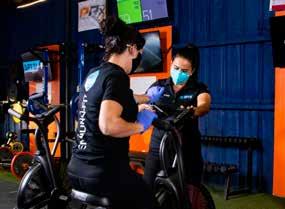

including open-gym exercise, circuit-based training, 1-to-1 personal training, sports performance, and skill training along with that aforementioned injury prevention training and recovery.
Workouts are designed to unify the different muscle groups in the body to help make members feel and perform better in all aspects of life, regardless of if you stock shelves, sit at a desk, or play competitive sports.
DPTSI FIT offers eight heart-rate monitored classes and focuses on the proper use of weights, ropes, kettlebells, barbells, self-powered endurance machines, medicine balls, and more. Injuries related to people over-exerting themselves in the gym are far too common.
DPTSI FIT members and non-members are given the option to have a functional movement screening to assess participants' strength, balance/proprioception, mobility, range of motion and power. Members also
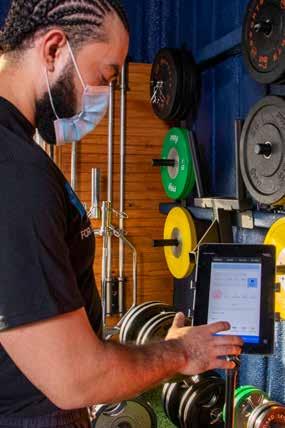
have an option to conduct a full body composition scan with the InBody 570, a high-tech device that can track fat loss, muscle gain, water levels, and more. Every step of your fitness journey can be tracked, monitored, and celebrated.
Since DPSTI FIT is part of the DPTSI family, wellness and recovery options are available in-house, including sports massage, cupping massage, hot-stone massage, joint manipulations, and dry needling. Members don’t need to be afraid of giving their all during their workout because top-notch recovery is under the same roof.
Consider DPTSI FIT your one-stop shop for exercise, health, wellness, recovery, and injury prevention.
The DPTSI FIT gym is located at 9120 N. 23 St. in McAllen. The DPTSI Clinic can be found in Edinburg at 5216 S. Jackson Road. For more information on their programs, visit dptsi.org or call them at (956) 205-2704.
67 RGVISION MAGAZINE . JUL/AUG 2021 HEALTH

A SIGHT BETTER
Dr. Raul Peña Focuses on Serving Valley at Peña Eye Institute
by Amy Casebier | photos by James Hord
Dr. Raul Peña learned early on just how crucial good eyesight is to people’s lives. Now, 21 years and thousands of patients later, Peña Eye Institute continues to serve the Rio Grande Valley community.
“I want to thank everybody in the Valley who put their trust and confidence in the Peña Eye Institute to help them see better,” Peña said.
Born in McAllen, Peña grew up in Reynosa. However, anything the family needed to do — shopping trips, going to the doctor — they did north of the Rio Grande. It was during one of those trips to the doctor’s office to address a childhood cold when Peña found himself inspired. His physician dazzled a young Peña by correctly naming his symptoms and identifying what was causing them.
“Right then and there I decided I either wanted to be a doctor or a fortune teller,” Peña said. “I decided to be a doctor and I think it’s worked out pretty well for me. I always wanted to be a doctor — I never wanted to be anything else.”
During medical school, Peña did a rotation in ophthalmology. The patient his professor and fellow classmates examined had a hypermature cataract. The man relied heavily on his daughter to lead him to and from the appointment — grasping along the wall with his other hand to ensure he didn’t trip and fall. After a successful surgery to correct the issue, the man came back to have the patch protecting his eye removed.
“His eyes lit up and then you couldn’t keep up with him,” Peña said. “The quality of life that you have with your sight versus not having it is incredible. That’s what made me want to be an ophthalmologist.”
Peña’s education took him across North America. He received his medical degree from the Tecnologico de Monterrey Escuela de Medicina, completed a residency in internal medicine at the then-Texas A&M Scott and White Memorial Hospital, and did another residency in ophthalmology at University Hospital through the University of Cincinnati College of Medicine.
It was in Monterrey, however, where Peña experienced
68 HEALTH RGVISION MAGAZINE . JUL/AUG 2021
something that would reshape his entire life. In December 1980, when he was 19 years old — and after a biochemistry final — Peña’s truck plummeted two or three stories from the roadway to the dry bed of the Santa Catarina river below. The accident totaled his vehicle, but Peña emerged unscathed.
“I was there just by the grace of God,” he said. “Ever since then, I’ve been trying to find out why God left me here on this earth and trying to help as many people as we can along the way. That’s why it’s important to give back: to help the patients who really need to be able to see and go on with their lives.”
Returning to the Valley after his studies was always the plan — even when a number of offers came in to try to keep Peña in the Cincinnati area following his ophthalmology residency.
“The Valley’s always been my home,” he said.
And there are plenty of people to help here when it comes to his practice. With the high prevalence of diabetes in the region comes conditions like diabetic retinopathy, which speeds up eyesight-robbing cataract formation. Coupled with residents’ widespread tendency to delay medical treatment and appointments, Peña and his team find they must address much more serious issues.
“Unfortunately, we see pathology once it’s already quite advanced,” he said. “Sometimes that’s a sad story because with ophthalmology, it’s better to prevent than to cure something that already happened.”
In addition to the IntraLASIK treatment the Peña Eye Institute is so well known for, Peña performs many other procedures, including cataract and glaucoma surgeries, ocular allergy testing, and much more. He added that he takes the time to completely explain each patient’s options with them before selecting the best way forward for that person.
“The Peña Eye Institute is always trying to help the patient. It’s always about doing what’s best for them,” Peña said. “The principle of the Peña Eye Institute to treat everybody as we would like to be treated — to treat everybody with respect.”
That includes staying up to date with advancements in ophthalmology and upgrading equipment and treatments, as necessary. It also means that Peña and his team are always looking for ways to give back — whether it's donating to local nonprofit organizations or traveling to different countries to provide life-changing surgeries through Heal International Medical Missions.
“Here in the Valley we don’t have to go across the world to help — we have those patients,” Peña said.
He often works with his team to identify deserving candidates for free treatment to restore their eyesight.
“We treat everyone with how we want to be treated,” Peña said. “I love what I do and I try to show that to the patients.”

“I want to thank everybody in the Valley who put their trust and confidence in the Peña Eye Institute to help them see better."
Dr. Raul Peña, Peña Eye Institute
69 RGVISION MAGAZINE . JUL/AUG 2021 HEALTH
LIGHT AT THE END OF THE TUNNEL
Youth Vaccines Mark A New Stage In Pandemic Response
by Nathaniel Mata

12 years old. This was a big step in the U.S. vaccination efforts and as another crucial step in ending the grip of the pandemic on our society.
“We all have family members that we care about, especially the young ones,” said Dr. Robert Martinez, who serves as Doctors Hospital at Renassaince’s chief physician executive and chief medical officer. “Despite hearing ‘they don’t get the disease or they don’t get sick,’ when it’s your child, it’s as important as anything else. I think peace of mind is important for everyone. We know that children can be spreaders of the disease, they can harbor the disease, they can carry it, and
COVID complications.
“Some children do get sick and develop devastating after effects,” he said. “There have been disorders and syndromes that render these kids really sick and some of them die and we want to avoid that, if possible, and this vaccine gives us the ability to do that safely.”
The availability of vaccines for youths aligns perfectly with the end of the school year. He mentioned how during school months it might be difficult to find time to schedule and get a shot. Now, with children out of class, it should be possible and not have to worry about missing anything with potential side effects.
HEALTH 70 RGVISION MAGAZINE . JUL/AUG 2021
When it comes to your to-do list, put your future first.
“We all have family members that we care about, especially the young ones. Despite hearing ‘they don’t get the disease or they don’t get sick’ when it’s your child it’s as important as anything else.
Dr. Robert Martinez, DHR’s chief physician executive and chief medical officer
To find out how to get your financial goals on track, contact your Edward Jones financial advisor today.
“The immunity builds in such a way that if you get your vaccine in the summer, by fall, those folks should be well immune and safe from COVID,” Martinez said.
Children pose a unique risk, he added.
“Kids this age, they’re hard to control. They’re not going to tell you something sometimes,” he said. “They’re less clear, they’re not really paying attention to what they’re doing, playing in each other’s faces a lot of the time. That’s a reason why it’s so important to vaccinate them. Then they can get back to their normal lives, concentrating on school and building relationships with their friends.”
 Advisor
Advisor
As of early June, the RGV was ahead of the state average when it comes to the vaccination rate at 55%. Dr. Martinez said the 12-year-old to 16-year-old age group could play a big role in getting the rate up toward immunity and dramatic decrease in spread.
“Even though this age group makes up about 15% of the population, this might be the 15% that gets us over the hump from 60 to 65% to 80 to 85%,” he said. “That’s when you start talking about a good herd immunity number when people can start to feel better and go out and enjoy a regular life without something devastating potentially happening.
They’re an important part of the mix.”
DHR has been instrumental in the vaccine efforts. It was the first institution to offer mass vaccination clinics and has continued that momentum months after the first shots.
“We really looked at a big problem here and the only way we were going to be able to get this better and out of the way is if we put our heads down [and went to work],” Martinez said. “We were vaccinating not just this county but everyone in the region so they could feel better about moving around and doing what they need to do.”
The veteran doctor left a message and reminder about the importance of public health and community preparedness for the future.
“A lot of our students, a lot of our physicians learned a lot about this segment of emergency pandemic response,” Martinez said. “Public health and getting everybody from county to cities to the state to care about public health. They see how important public response is. They need to start thinking when they are budgeting about these programs and public health and how important these things will be the next time — and there will be a next time — in getting our community to feel safe.”


FAP-1966E-A edwardjones.com Member SIPC
To find out how to get your financial goals on track, contact your Edward Jones financial advisor today. Leonardo F Chang Financial Advisor 4500 N 10th St Suite 40 Mcallen, TX 78504 956-630-0241 www.edwardjones.com Member SIPC MKD-86 5 2BA
it
to your to-do list, put your future
Leonardo F Chang Financial
4500 N 10th St Suite 40 Mcallen, TX 78504-0241 956-630-0241
When
comes
first.
71 RGVISION MAGAZINE . JUL/AUG 2021 HEALTH
GETTING HISTORY
New Foundation Connects Local Artists to Community
by Jose De Leon
III | photos provided and cover photo by Melissa
For James McAllen, art is a way to express himself.
“Supporting the arts,” McAllen says, “is important to the vitality of any community. It inspires and gives creativity to kids and individuals who want to express themselves however they see fit. Art rounds out the community because many times, ideas and thoughts can be expressed better in the visual arts than in words to help us think about the society we live in. The RGV has a lot to offer and unique perspectives that can be created and expressed in our area through art."
His wife, Katherine, also shares his love of art. "She is an art historian, a professor at UTRGV and Director of the Center for Latin American Arts there, so both of us love art and value teaching our children and other young people about art and history," he said.
As the founder of the Guadalupe el Torrero Foundation (GeT), located in Puerto Rico in northwest Hidalgo County, McAllen also gets to preserve a vital piece of Texas history and share it with the community.
Rancho Guadalupe is a former cattle ranch founded in 1804 when Julian Farrias from Camargo, Mexico was granted the land from the King of Spain as a Spanish land grant. El Torrero (the light tower) was the name of a watering hole on the ranch where thirsty travelers and
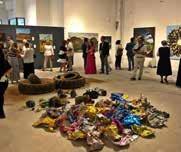 Guerra
Guerra
animals gathered to drink water after heavy rains. This small region of present-day Hidalgo County became known as Guadalupe el Torrero to recognize the important water source and the ranch in which it inhabits. It’s believed over time, the name of the area mistakenly evolved to el Torero (the bullfighter), because its importance and meaning faded into history. Although, the original land grant and map labels identify this water source as el Torrero.
"We have a dynamic history and a wonderful community of people, who have been here for centuries," McAllen said. "This property has existed through two Mexican wars of independence, the Mexican-American War, Civil War, and several battles that impacted this land. This history should not be forgotten, honoring those who came before us. The buildings we have restored will remain preserved so our community can see local historical architecture.
"I believe it’s important to know your history if we are going to build a better future," McAllen added. "The GeT Foundation looks forward to teaching with the visual arts as our guide and inspiration. These structures serve as a backdrop and active participant in our future education goals.”
McAllen purchased the 9-acre tract of land in 2004, which contained the three remaining structures from


72 LIFE RGVISION MAGAZINE . JUL/AUG 2021

73 RGVISION MAGAZINE . JUL/AUG 2021 LIFE
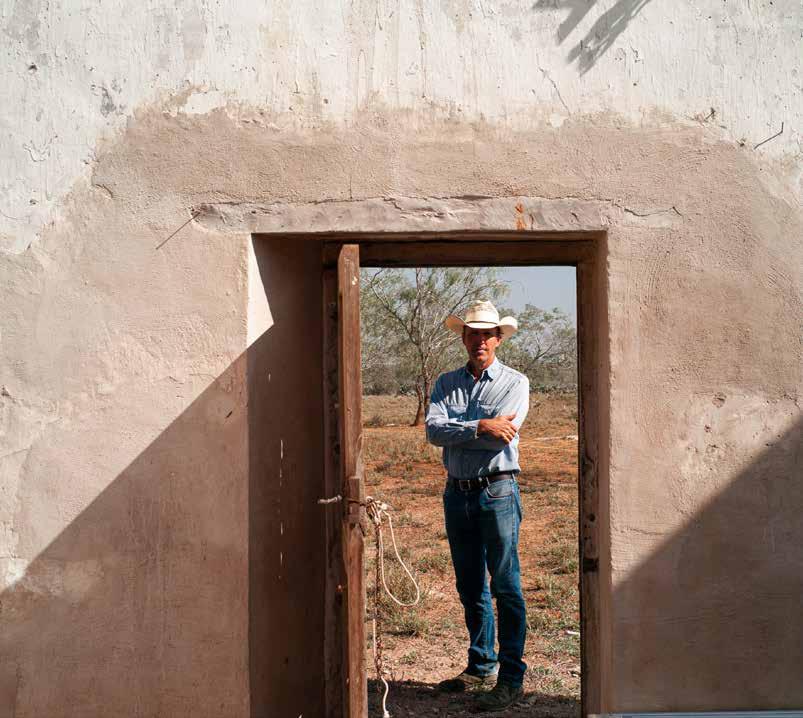



74 LIFE RGVISION MAGAZINE . JUL/AUG 2021
photo by Jason Garza


a colonial cattle ranch that predates Texas by 40 years. In the fall of 2019, McAllen and his wife decided to restore these dilapidated structures to preserve the initially built architecture when the ranch was active with sheep and cattle.
"It's great to be connected to so much history," McAllen said. "I find it fascinating being able to look at those times that predate Texas and get an idea and understanding of how this region began. I get a better sense of a timeline and how I arrived to be in this place and land.”
Thanks to GeT Foundation, McAllen is finding a way to bridge his love of art and history — and inspire artists throughout the region.
The McAllen’s started the GeT Foundation, which promotes the arts and education along the borderlands of South Texas and Mexico to foster collaborations between the arts and sciences to connect artists, students, and our community with the world.
McAllen will accomplish this by providing a place of gathering for community engagement, the exhibition of art, performances, and workshops to mentor students and help artists find support and success at Rancho Guadalupe.
McAllen said he got the idea for the foundation when he and his team were renovating the historic site.
"As I was going through the process of restoring these buildings, I wondered why I was doing all this," McAllen recalled. "I asked myself, 'why are we investing in renovations, and I remembered we're doing it strictly for the love of it and the love of history. My wife and I want to take it a step further and give back to the community and share this place.
"With the foundation, McAllen said he wants the history of the property to serve as the bedrock of the foundation to promote education and arts on the border inspired by contemporary art seen across the state.
"We feel there is a need in the Valley to support the arts and we have something to contribute to help collaborate with others involved in similar projects," McAllen said. "We want to create a space to make and enjoy art and be in a dialogue with other artists in San Antonio, Monterrey, or Marfa. We enjoy helping our community and have been involved in other organizations like the
Linn-San Manuel Community Improvement Committee foundation, which also donates to scholarships. We have followed these and other organizations, and we wanted to create our own with art in mind. We love art, and we want to spread appreciation for the arts within the community and bring more awareness to the area."
"I've enjoyed painting since I was in high school. I studied art in college and continue to create paintings even after college.”
"We want to start with helping kids in the community at the elementary, middle, and high school level, as well as college students, and artists in the Valley and Northern Mexico. McAllen said the foundation will support students and artists in the Rio Grande Valley and across the border. "There is amazing talent here in the RGV and in northern Mexico, so why not collaborate between both areas, learn from each other, and discuss some issues? We think connecting south Texas with our neighbors across the river can be done through art. If we're going to make things better along the border, I think it must come through further communication," McAllen said.
To help get the foundation started, McAllen had an art show in San Antonio to showcase his latest paintings, which were part of a collection titled "From the Brush." The paintings depicted McAllen’s experiences on the ranch and his contemplation of art and nature. The show, held in May in downtown San Antonio sold more than $100,000 worth of his paintings, and 100% of these funds were donated as seed money to the foundation.
“All of my work is oil on linen, and I will continue to paint as long as I can,” McAllen said. “I’ve always painted for my own creativity, and the timing could not have been better to donate my love of art to the next chapter of my life: the GeT Foundation. We had a wonderful turnout at the show, and it was a great success we hope to continue again in the future.” McAllen said the foundation plans to continue fundraising and eventually build a facility on the property to host art shows and conferences. “We’ve achieved a lot in the past seven months-we’re moving ahead,” McAllen said.
For more information on the foundation, visit gettexasart.org.
75 RGVISION MAGAZINE . JUL/AUG 2021 LIFE
BLOOMING AT QUINTA MAZATLÁN
Creating Habitat with Native Plants
by Quinta Mazatlán World Birding Center-Urban Ecologist-John Brush
A summer’s walk through Quinta Mazatlán is full of life. Butterflies, from the tiniest Clytie Ministreak to the largest Giant Swallowtail, flit across the paths in dappled light. Plain Chachalacas scamper loudly through the understory and clamber up Anacua trees, searching for fruits to feed their chicks. Great Kiskadees and Green Jays voice their opinions from the verdant canopy of Honey Mesquite, Texas Ebony, and Brasil trees. Bees buzz happily by, off to gather or store pollen.
Behind all this activity, whether bursting with color or subtly blending into the foliage before our eyes, are the flowering plants that power the thornforest and its wildlife. Flowers, just like the plants that bloom them, come in a vast array of sizes, colors, smells, when they open.
Despite making up the majority of the large bushes and small trees at Quinta Mazatlán, common thornforest species like Brasil, Lote Bush, and Granjeno all have tiny flowers. Yet, after being pollinated by bees and flies, the fruits that develop from the flowers fuel thrushes, thrashers, kiskadees, kingbirds, chachalacas, mockingbirds, orioles, and so many others of the Valley’s diverse bird community.
Though plants of smaller size, the wildflowers of Quinta Mazatlán provide plentiful food for six-legged animals — the bees, flies, butterflies, and moths so important for their pollination services. A walk past the restored pollinator meadow in Ebony Grove is a colorful adventure. Yellows burst from Parralena, Huisache Daisy, Cowpen Daisy, Common Sunflower, and Plains Coreopsis.
Red, pink, and purple hues radiate from Scarlet Sage, Redwhisker Clammyweed, and Silverleaf Nightshade. White emanates from Prairie Milkweed and Sticky Florestina. Each pollinator seen in the vibrant array proof of restoration at work.
One Quinta Mazatlán’s goals is to serve as an example for creating habitat with native plants (and sustaining all the ecosystem services they provide). In the case of wildflowers, it is as simple as selecting a sunny location, preparing the soil, and scattering seed — plus a little water. For example, if you are wanting less lawn to mow and water, a pollinator patch of wildflowers is a great solution.
First, remove a patch of lawn; this can be done passively by covering it with a tarp or cardboard, or actively with a shovel or other garden tools. Second, loosen the soil to make sure your seeds come into good contact and roots can get a footing. You can do this with a shovel, cultivator, or tiller. Third, scatter seed! Just make sure it is a wildflower native to the region. You can check on what plants are native using the USDA Plants Database or the National Wildlife Federation’s Native Plant Finder. Lastly, make sure to keep your soil moist after seeding it — at least until you start to see your wildflowers germinate and grow.
For more ideas of what native plants you can use for your landscaping project, visit Quinta Mazatlán at 600 Sunset Drive in McAllen. Follow Quinta Mazatlán on Facebook, Twitter, Instagram, and YouTube for announcements on programs and special events. Have fun wildscaping your garden!



76 LIFE RGVISION MAGAZINE . JUL/AUG 2021





 Cowpen Daisy
Sticky Florestina
Firewheel (Gaillardia pulchella)
Cowpen Daisy
Sticky Florestina
Firewheel (Gaillardia pulchella)
Plains Coreopsis
Redwhisker Clammyweed
77 RGVISION MAGAZINE . JUL/AUG 2021 LIFE
Upright Prairie Coneflower (Mexican Hat)

RGVISION FOOD FAVE
A LITTLE PIECE OF MEXICO
Weslaco Restaurant Shares Its Story
by Elisa Garcia | photos by Norma Hess
You can find just about any Mexican food restaurant in the Rio Grande Valley, but one stands out among the rest: Nana’s Taqueria. Easily recognizable by the building’s colorful Otomi-inspired murals and outdoor setting, Nana’s Taqueria has created a space of celebration for its guests for the past 11 years.
Owned and operated by the Treviño family, Nana’s Taqueria offers various authentic Mexican food made from fresh local ingredients such as tacos, burritos, tortas, quesadillas, churros, and more. The Treviño family hails from Nuevo Progreso, Mexico, where lonches originate from. The dish is now a Nana’s specialty.
Roxy Treviño, the eldest daughter of Alfredo and Roxanna Treviño, in charge of the restaurant’s development, inventory, and social media presence, explained the goal of Nana’s is to transport people to the part of Mexico where their family is from.

RG V I S I ON FOO D F AVE
78 LIFE RGVISION MAGAZINE . JUL/AUG 2021


“That’s the heart of Nana’s, like really trying to be as authentic and respectful as possible. And trying to create that sensation of home,” she said. “That home, some of us might know it, some of us only know it through stories that are around us. But we all have a sense of what that is. And we wanted this place to embody that. I think that was at the heart of what my parents tried to do. They put a lot of love and heart into what they do.”
Mr. and Mrs. Treviño founded Nana’s Taqueria in January 2010 after leaving their 15-year-old Mexican folk art store in Nuevo Progreso due to the increased border violence heightened by the 2008 U.S. recession. With four kids and growing debt, they decided to embrace their Mexican roots and love for street food and started a taqueria in a little shack next to their house in Weslaco.
Nana’s Taqueria started with Mrs. Treviño as the only cashier and waitress and Mr. Treviño running the kitchen and a six-table dining room. Today, Nana’s is one of the few restaurants that can seat a table of two or 50 people at a moment’s notice on their patio. They can also help celebrate wedding rehearsals, birthday parties, cultural events like Día de Los Muertos, and weekly mariachi nights from 7 to 8:30 p.m. Thursdays and Fridays.
“Our love for our culture has stayed intact since the beginning, and as we grew, we made sure to express it through every detail of the architecture, murals, and general ambiance of Nana’s,” Mrs. Treviño said. “We have come full circle and have even opened a small artisanal folk art gift shop next to the restaurant called Shop Para Mi. We work hard every day to add to Nana’s experience and bring a little piece of Mexico to Texas.”
Roxy explained the family environment has helped customers feel at ease, allowing them to feel as if a tío or tía is serving them. Nana’s Taqueria’s sense of familia is also reflected in its staff, with Roxy’s sisters, tía, and grandpa all pitching in to help.
The biggest testimony to Nana’s atmosphere of family and camaraderie is when staff and customers found out Mrs. Treviño was battling breast cancer in fall 2020. Roxy recalled staff showed up in front of the Treviño’s house, holding signs of encouragement and flowers to support the family.

“I think that is the bigger point to be made. The number of customers that come, some that we know and some that we don't know, they're like, ‘Hey, we heard about Roxanna, and she's on our prayer list at church.’ Or they'll bring remedies that work for them or share their story,” Roxy said. “I think that's been a true testament to how amazing our customers are and how amazing our community is.”
Roxy explained her mother and father have had to take a step back from the restaurant while her mother’s health improves. Since then, Roxy said she and her sisters have had to step up and make sure Nana’s was in order.
“(We’re) trying to make her proud even though she can't physically be here,” she said. “(Her treatment) is preventative. Because (the cancer) did go away. She's so ready to get back in the game, and we're ready to have her. The team here loves her. They stepped up and really try to make her proud because she is like the Boss Lady here, and they all see her as a mom figure.”
Now a Valley staple, Roxy attributes the restaurant’s success to the simple and homey environment and welcoming staff.
“As long as the restaurant is open, you have to be, ‘Yes, keep your head in the game and make sure that everything is taken care of’ because everyone's coming in with a different experience,” she said. “As long as you keep consciously working on improving that experience. I think that's what will help you make it and never take anything for granted.”
The Treviño family is constantly cooking up new ideas at home to keep the restaurant fresh and ensure customers feel a little piece of Mexico throughout their entire dining experience.
To further enhance the Nana’s experience, the Treviño family is looking to expand their kitchen and parking lot.
“One favorite thing I love reflecting on is seeing my parents where they're at now and knowing everything they've been through,” Roxy said. “Now I’m trying to put my little grain of salt into this story. I've always thought (my parents) were amazing, but this experience makes me that much prouder of them.”
Nana’s Taqueria is located at 1802 S. International Blvd. in Weslaco along with their gift shop Shop Para Mi.
79 RGVISION MAGAZINE . JUL/AUG 2021 LIFE



80 LIFE RGVISION MAGAZINE . JUL/AUG 2021


MONTEZUMA BALD CYPRESS Visit the Valley
Under the Shade of Ancient History
by Nathaniel Mata | photos by Mark Puente
Our South Texas climate is no joke, but you shouldn’t let that stop you from having exciting adventures outdoors. The RGV is full of history in architecture, culture, or in this case, nature.
This is the second part of the Visit the Valley series and this time, we will explore a tree that is older than the nations of Mexico, Canada, and the United States combined.
The Montezuma Bald Cypress of Abram, Texas, near the Rio Grande, is 900-plus years old. If trees could talk, it could tell thousands of stories. Tales of empires, natives, conquest, settling, and today, a vibrant Rio Grande Valley on the border.
Studying these trees and the reason they are so far north from Central and Southern Mexico, where the Aztec civilization was centralized, can open a world of discovery and history.
“A lot of the people in the Valley tend to overlook a lot of the beautiful natural things that are here,” said local historian, professor and organizer Ruben Flores. “Very few people know about El Sal Del Rey or the Ahuehuete tree. That’s part and parcel with it.”
The tree is near the border, behind a steel gate built by the federal government but still accessible to residents — albeit with some border patrol presence. Making a trip to see this special piece of nature is something that’s hard to forget, especially with background knowledge.
These Bald Cypresses (taxodium muctonatum) were commonplace in the Aztec Empire. The largest tree of its kind is located in Oaxaca, but the tree in Abram shows the extent and migration patterns of the empire. They can be found in many parts of Southern and Central Mexico.
“When I first heard about the one in Abram, I was excited,” Flores said. “It’s smaller [than Oaxaca’s] but it’s the same type of tree. The Aztec saw it as a symbol of government, so they planted it throughout
their kingdom and that included here. They traveled up north to El Sal Del Rey to get salt.”
Flores said that he has been fascinated with these trees since he traveled to Santa Maria Del Tule in Oaxaca to see the Arbol del Tule, or Ahuehuete.
“If you see the redwoods in California, you stand there and you’re in awe,” Flores said. “It’s that same feeling when you see the Ahuehuete — it’s immense. It is literally the largest living thing on Earth. It can be compared to the Blue Whale — it’s even bigger. The circumference of the tree is as big as it is tall.”
The tree in Oaxaca is almost 2,000 years old, while Abram is 900 years old. (Still some room to grow and catch up!)
Central and Southern Mexico are home to many of these Aztec-planted giants that were a sign of political, social and agricultural prowess. Montezuma is the name of the final ruler of the great Aztec empire that stretched into modern-day America and south to Honduras and Nicaragua. He is known for this period and his confrontations with conquistador Hernan Cortes.
Cortes is said to have cried under the tree in Santa Maria Del Tule after being chased out of Tenochtitlan (Mexico City) by Mexica forces.
Research says these trees were planted alongside the advanced agriculture systems of the indigenous people. The resin was said to be used to treat gout and ulcers, the bark boiled to promote menstrual and bladder health, while the leaves were used to stop itching.
Flores says that in order for the tree in the Valley to be protected, it would be wise to designate the tree as a historical marker. This would preserve the giant from destruction or construction.
“The first thing we plant when we take over a region is a flag,” Flores said. “What did we plant on the moon? We plant flags, they planted trees.”
81 RGVISION MAGAZINE . JUL/AUG 2021 LIFE
Farm Sweet Farm FACES OF THE VALLEY:
Nature’s Heartland Farm Discusses the Advantages of Shopping Locally
by Elisa Garcia | photos provided
Most people have no idea where their food comes from or how it’s grown. In Edinburg, there stands a family-owned and -operated farm that believes knowing where your food comes from is a comfort that all consumers are entitled to. According to its website, Nature’s Heartland Farm works to grow fresh, organic produce, allowing its customers to pinpoint precisely where their groceries are produced.
Founded in 2003 by the Hernández family, they run the 9.4-acre farm with no extra external help. Nature’s Heartland Farm solely relies on the communities’ support, farmers’ market sales, and the CommunitySupported Agriculture (CSA) program, a food system that connects the producer to the consumers more closely.
Civia Hernández, daughter of Miguel and Maria Hernández, explained her father grew up farming and always grew produce for the family. But, when Miguel was introduced to the CSA program by a family friend, he felt inspired to bring the community together and teach people about eating healthy.
“Our main goal is to provide the community with a healthy supply of vegetables that are in season and at a lower cost,” Civia said. “One of the things we’ve noticed is when shopping at a grocery store, the prices of organic and natural foods are higher than commercial items. We want to provide a product that is affordable to everyone.”
Customers can purchase products under $5, such

as orange carrots, red beets, yellow onion, salad tomatoes, rainbow chard, green kale, Brussels sprouts, leeks, celery, chicken and duck eggs in person at the farm. They can also find produce at the McAllen and Harlingen Farmers Market and through the CSA program for $101 for the year they can order online and pick up curbside. All produce is grown without the use of chemicals or pesticides.
Currently, the Hernández family has about 30 different varieties of vegetables growing on their farm. During the winter season, a peak growing time in the RGV, the farm has about 100 different types of produce growing at one time.
“There are so many advantages to shopping locally. (The produce) is fresher than at a big chain grocery store, and you’re building a relationship with the farmer,” Civia said. “I know almost all of our customers and have conversations with them. That’s one of the biggest perks of going to a farmers market because you’re able to interact with people. I would say our customers also like that aspect of having a connection with us.”
When COVID-19 caused local farmers’ markets to close for nearly a year, Nature’s Heartland could no longer connect with their customers in person. Civia explained their online shop was a saving grace when it came to running their business during the pandemic.
Nature’s Heartland’s website was created in December 2019 as a promotional tool but did not
LIFE 82 RGVISION MAGAZINE . JUL/AUG 2021


launch with the online shop feature. Customers were able to purchase products online and pick them up using curbside at the farm.
“I created our website in December 2019 to promote the farm,” Civia said. “We didn’t have the online shop yet, but when the stores started closing down, I quickly added the shop online feature, and we had a great result. That was our main source of income. It was life saving.”
Nature’s Heartland sells its products via its online shop, CSA membership program, and local farmers’ markets. Civia said she and her family look forward to continuing to help the community live healthier lifestyles.
“I have people tell me how they don't get sick very often and how before they started buying vegetables from us, they used to go to the doctor quite a lot,” Civia said. “And they would get prescribed medication for things. And


now they're like, ‘No, I don't get sick as much. I go for my checkup, and the doctor says I'm perfectly healthy.’ So we love to hear those stories about our customers and how buying locally and buying naturally grown vegetables from us has helped them in their life.”
The farm’s future plans consist of cooking up YouTube videos showcasing a wide variety of recipes. One can find videos of Chef Marcel, a chef and instructor at McAllen Culinary Academy, walking viewers through various recipes that include vegetables from Nature’s Heartland. Civia said she hopes they can continue collaborating with local Valley chefs for their customers to learn more about healthy eating.
Nature’s Heartland Farm is located at 11920 Mile 16 North in Edinburg and can be found at the McAllen and Harlingen Farmers Markets.




83 RGVISION MAGAZINE . JUL/AUG 2021 LIFE

APIARY BUZZ
by Nathaniel Mata | photo provided Local Beekeeper Spills the Honey on What's Buzzing for the Future of RGV Bees
In case you didn’t know, bees are an important part of our ecosystem — to flora and fauna and of course for producing honey.
Along with making sweet honey, they drink nectar and move pollen to help flowering plants spread their seed. In essence, they are very crucial to the natural world, even if we don’t see them every day.
Even less known is the grind of taking care of bees, staying safe around them and doing the painful work of handling the stinging and sometimes unpredictable swarm.
“Over the years we have seen how vital bees are to our planet and for a lot of things we do daily as far as food production,” said Jimmy Lawrence, president of the Rio Grande Valley Beekeeping Association. “Bees are involved with every aspect of plant pollination. That’s fruit, trees, shrubs, weeds, you name it. Also goes into how bees help plants repopulate the earth.”
LIFE 84 RGVISION MAGAZINE . JUL/AUG 2021
When you ask Lawrence about beekeeping, also known as apiculture, it's hard to get him to stop. That’s because you can hear the joy, passion, and excitement he has about bees from a mile away. He wasn’t born into the beekeeping life, but was hooked as soon as he learned the trade — even getting his father into beekeeping.
“I used to think I was allergic to bees — I got stung as a kid and it welted up,” he joked. “When they were around me I was dead scared of them. But I started brewing mead with my grandpa. Mead is the oldest alcoholic beverage that was ever discovered. We were buying honey from a local beekeeper named Luis Layton. He is a master beekeeper and a real risk-taker in this field.”
Lawrence is by no means the first person to keep bees in South Texas. He says he learned from mentors and friends and took the bull by the horns … or the bee by the stinger.
“One day I just decided that I was going to get bees and I was going to produce honey,” he said. “I got my stuff from a Beekeeper that had passed away, his name was Bill Vanderput. He was one of the last old commercial beekeepers in the Rio Grande Valley. We called it preAfricanized times.”
He not only sees bees every day, he lives
them — requeening hives, helping fellow keepers get on their feet, and sitting at the head of the RGV Beekeepers Association. It’s not an easy sell these days because of the skill it takes to handle the African/Killer Bee hives.
Africanized Bees or Killer Bees sound pretty scary and that’s because they can do some serious damage as an angry hive. They are the same species of honeybees as in Europe, but the ones living in Africa began to develop some strong defense mechanisms against their natural predators.
In 1956 East African Lowland Honey Bees were brought to Brazil to crossbreed and help increase honey yields. A year later, 26 swarms escaped quarantine and since then, it’s been a northern march for these overly aggressive bees.
The 1990s is when these bees became more and more prevalent in the Rio Grande Valley, changing the dynamics of apiculture.
“Africanized bees breed down here at a 99.98% breeding rate,” Lawrence said. “Let’s say I have a hive that has a European queen. That hive I can work in a T-shirt and shorts if I wanted to. With the Africanized bees, one mistake and you might have a pretty bad time.”
Unfortunately in the Valley, since most of the bees are more aggressive in nature, you would



85 RGVISION MAGAZINE . JUL/AUG 2021 LIFE
Jimmy Lawrence, president of the Rio Grande Valley Beekeeping Association.

have to be a bit of a daredevil to take up this field. Lawrence says getting stung is a given — but not necessarily being swarmed.
“When you get past San Antonio toward the Valley, they call that the quarantine zone in Texas,” he said. “I wouldn’t say it’s extremely dangerous if you have some experience. Small mistakes will turn a hive that’s tolerable into a situation that’s really not working out.”
As the president of the Rio Grande Valley Beekeepers Association, Lawrence still does as much as he can to encourage people to join. But being knowledgeable of what it takes from a land, equipment, and safety standpoint, he does his fair share of vetting.
“There’s a lot of upcoming people that want to keep bees but don’t know what to do. I get a lot of messages,” he said. “I try to help people but I’m also very careful with who I try to help. If you live in the city and you put a beehive in your backyard, your neighbor that is mowing the grass will get attacked eventually. I’ve helped a lot of people get started with bees. Some people do really well and some people, once they find out about Africanized bees, they just put everything up and forget it.”
High start-up costs is another factor keeping the Valley from a big boom of bee business.
“It’s really expensive to keep bees,” Lawrence said. “The wood is expensive, the gear is expensive, and on top of that, you have to re-queen your bees once a year or else they are going to be aggressive. So it’s really difficult if you don’t have the land that is required to maintain a beehive. It can
“One of my biggest goals since restarting all of this is I wanted to do a lot of outreach to young people, young adults. Ultimately that’s going to be our next generation of beekeepers.”
Jimmy Lawrence, president of the Rio Grande Valley Beekeeping Association
pose a threat to the animals, pets, and of course people.”
He does have a vision, however, of how to get the skilled trade into the hands of younger people. He said he wants 4-H or FFA to add beekeeping programs so that these skills can be taught to enthusiastic, animal-inclined youths — not very different from how these programs teach raising livestock from adolescence.
“One of my biggest goals since restarting all of this is I wanted to do a lot of outreach to young people, young adults,” Lawerence said. “Ultimately that’s going to be our next generation of beekeepers.”
He recalled a class of students in Hidalgo who got interested in beekeeping. They raised funds as a class and kept bees for a whole year. Lawrence believes as long as that interest is there, as long as curiosity and training can overcome fear and hurdles, the next generation of apiculturists is here in the Valley.
86 LIFE RGVISION MAGAZINE . JUL/AUG 2021







1607 St. Claire Avenue, Edinburg | (956) 460-3290 | info@infinityhomesrgv.com RESIDENTIAL HOMES AND COMMERCIAL BUILDINGS Custom construction with endless possibilities. infinityhomesrgv.com An Infinity Custom Construction L.L.C. Company

Fish Fiorucci
88 LIFE RGVISION MAGAZINE . JUL/AUG 2021
A Brownsville Native Tackles Fashion and Gender Norms by Steven Hughes | photos provided
The Brownsville Fashion Week (BFW) was held on Zoom last year because of the COVID-19 pandemic. During the week of May 2430, designers, stylists, and models hosted workshops regarding photography and makeup, to name a few. Alongside daily workshops, the event had five runway shows broadcasted on BTV local Brownsville network, Spectrum Cable Channel 1300, and Digital TV Channel 12. One of the presenters was Nolan “Fish Fiorucci” Navarro, a Brownsville native. Navarro (who uses they/ them pronouns) worked behind the scenes for BFW. They produced graphics for the event and edited videos for TV. Navarro also dressed up every day during the week to show the 300 participants how serious they were about the event.
Navarro has garnered more accomplishments alongside hosting BFW, such as being profiled in Vogue and Texas Monthly and starting a modeling agency in the Rio Grande Valley.
However, they struggled to land jobs when they were younger while living only in Texas. Once they moved to New York City, they felt accepted because of the culture. For example, seeing half-naked models walking around is not uncommon. Before coming to New York, they lived in Austin. There, Navarro was interning at a modeling agency and was offered a chance to be a model at it. After they signed with the agency, the Valley native headed north to New York.
“I was not expecting to get [signed], I was not expecting to go in for that kind of conversation only because I felt like I had not prepared myself enough to get in that position,” Navarro said on Zoom. “I mean, I’ve prepared other people, but for me, I didn’t think I would get the chance to play the model.”
With the opportunity, Navarro wanted to bring three male models with them who lived in several cities such as Brownsville, San Antonio, and Corpus Christi. The group of Texan models has known each other since high school, according to Navarro. However, Navarro and the three models needed an affordable place to stay in New York City. Thus, the Texan models stayed at Ruth

Elizabeth’s apartment, a friend of Navarro. The two met back in high school, but she left, and “nobody knew where she went,” Navarro explained. They reconnected during a spring break at a vegan restaurant in New York, where Elizabeth worked as a waitress. After exchanging pleasantries, Navarro asked her about affording an apartment in the city. She mentioned to Navarro that she had an extra room, and “her landlord never comes to check up on it,” they added. Thus, Navarro and the three models lived in a 5-foot-tall apartment, each paying $200 for rent.
“I wasn’t going to pay $800 to $1,200 for a single room, I had to find something that I could [afford] for the meantime, when I was, you know, 18 years old and just out of high school with no money,” Navarro said. Navarro’s first visit to New York City culture-shocked them. They felt similarly when in Austin, but New York City “was an extreme culture shock for me,” they said. The Valley native fell in love with the city. They could comfortably walk down the street half-naked in their heels. However, if they did that in the Rio Grande Valley, “[people would] want to take [pictures, and] they want to annoy you or whatever,” Navarro said.
Every visit since then is all business. Navarro mentioned they have never been to the Statue of Liberty or the 9/11 Memorial. They said their work does not have opportunities to tour the city.
“There’s always times where I get a call [for a meeting and] it’s 45 minutes away, and the meeting [is] going to be in 30 minutes,” Navarro recalled. “So it’s always on the go, I never [had] the time to be in one place long enough without me getting [a] call or [receiving texts] that I have to be somewhere else.”
Navarro grew up and currently lives in Brownsville. It is where they started their fashion career. They first worked behind the scenes setting up shows at clubs throughout the Rio Grande Valley. The shows they put together were “chaotic fashion shows at the [clubs],” they said.
“I [wanted] to do … crazy curated events that are in the middle of nowhere, and that’s what I do now,” Navarro said. “But back then, it
89 RGVISION MAGAZINE . JUL/AUG 2021 LIFE

was just something I had to experience to make my way into the rest of [the growing fashion scene in the Rio Grande Valley].” Downtown Brownsville is where Navarro does their work when in Texas; their apartment is near their agency. The area is also where Navarro escapes from their parents. Once, Navarro’s parents hid the model’s heels in their attic, but they found them in an “extremely hidden” spot.
“My parents are very conservative and extremely religious,” the non-binary model said. “They always push that religious agenda on me. I grew to accept who I am and that came from separating myself from them as much as I can without disrespecting them. So, it’s just kind of like this love-hate relationship.”
The model faced struggles beyond their home as well. Specifically, being bullied while in elementary to high school sophomore year in Los Fresnos. After being sexually assaulted as a junior in high school, their parents transferred them to
Hanna Early College High School in Brownsville. Starting fresh at a new school helped them express their interest in fashion because of a different dress code policy.
“I popped into this new school with a whole new attitude, a whole new look, and just walked in with the confidence that I never thought I could have before,” Navarro said. “It was just kind of preparing myself to walk into the door and sell this story that people didn’t know I was doing or had hidden in my mind.”
Before they garnered attention, Navarro kept their interest in fashion private because they were scared people would judge them. There were not any extracurriculars they felt like they belonged to, which added to their fears.
“I wanted to do something outside of school that was hidden from the people who I was going to school with because I didn’t want them to know what I was doing,” Navarro said. “I felt that I was building myself up underground for a few years until I felt like I had some kind of success in it … to let people know what
90 RGVISION MAGAZINE . JUL/AUG 2021 LIFE

I was doing.”
After high school, Navarro participated in New York Fashion Week. That is when they realized their career was getting “serious.” This was also when they revealed their work in the fashion industry.
“I didn’t want people to feel like I was lying to them or telling them a fake story about what I was doing outside of [school],” they said.
The fashion between the late ’90s to early 2000s is the inspiration for Navarro's style. They also got ideas from how their sister dressed during the decades. The model described their look as “alarming when you see it.”
“It gets people … [to] just stare at you for 30 minutes,” Navarro said. “But I only do this because I feel like visibility is extremely important. If I didn’t dress that way I did, people wouldn’t be exposed to [it].”
Alongside their work in fashion, they are a mass
communication junior at the University of Texas Rio Grande Valley. The public relations coursework they do helped them link the major to their career. It will also aid Navarro if they are not modeling in the future.
“I see myself working in the fashion industry for the rest of my life and whether [as] a model or where it’s not modeling anymore, it’s always going to tie into fashion,” Navarro said.
Navarro is an experienced model. They wanted to share their expertise with the Valley, so they established f10, a sister company to an agency in London called The Contact Agency. The goals of f10 are to help models shine and challenge beauty standards. The agency is the first in Texas to sign a transgender model, a historic accomplishment to Navarro.
The advice Navarro gives to models is to research. There is exploitation and abuse in the industry; Navarro encountered it themselves while at jobs. They also encourage models to speak up about it.
91 RGVISION MAGAZINE . JUL/AUG 2021 LIFE
RGVISION FICTION FEATURE
THE MIGRANT LIFE
story and photos provided by Arturo Murillo
It’s almost the end of April and my parents already making plans on when to make our summer journey to our second home. The beautiful state of Idaho. Daddy sending a money order to the labor camp post office to secure housing. As we gather around the kitchen table we listen to what lays ahead for this nomadic family of humble peasants. It’s a long road to our destination. Knowing that we must say goodbye to our friends in the Rio Grande Valley and rejoicing in the fact that we have friends waiting for us in the valley of treasure. I always longed for those moments. The trip. Looking outside through the small window of the camper of our truck and savoring every view outside. The flat barren landscape of Texas is left behind while the majestic mountains of New Mexico. Colorado. Utah. Come into view. The transformation of life becomes evident. Mesmerized by the dark skies and seeing the beautiful cities alight with fire as we journey by like meteors towards our destination. How I miss those magical moments. Never knowing if I will ever come close to heaven like I did during those treks. The quietness of the small space I called my own inside that camper. Savoring every view. Keeping it deep inside my heart never forgetting that this is who we are. Proud. Humble. Vagabonds. Chicano. Fighters. Blessed and determined individuals with a story to tell. Calling ourselves migrants yet knowing that we are more than that. Knowing we are what our parents have always wanted us to become. The voices and storytellers of their struggles to mold us into who we are today. Never forgetting who we are because of them. Our jefitos. What would we become if not for them. Look at their battered hands. The story begins at their palms. The journey is there for us to see. If we could only open our eyes. • Chema

92 LIFE RGVISION MAGAZINE . JUL/AUG 2021

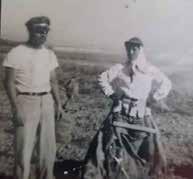


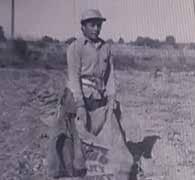




93 RGVISION MAGAZINE . JUL/AUG 2021 LIFE
HARLINGEN ARTS DISTRICT
Shoppers Can Discover Antiques, Collectibles, and Vendors
by Alma Guerrero Barham | photos by Mark Puente
If a destination is, by definition, a place people will make a special trip to visit, then Jackson Street in downtown Harlingen is the epitome of a destination. Needless to say, Saturdays are the busiest shopping days.
It all began approximately 30 years ago with the first antique mall and some brave entrepreneurs with a vision. The Emporium is, to this day, going strong — despite the COVID-19 lockdowns. The Emporium is located on the corner of Jackson and Second streets. It offers a neverending supply of antiques, collectibles, and vendors. Shannon Ramirez, the manager, is an absolute ray of sunshine and is ready to help with knowledge and a personality that won't quit.
Another major draw on Jackson Street is Market Days, an event held the first Saturday of every month. Its beginnings were small, starting with a handful of vendors. Now, it has grown to approximately 200 vendors. All in all, they encompass eight blocks of antiques, art, artisans' works, food vendors, live music, a farmer's market, and an

ambiance that is hard to surpass. Following the lockdown, it will once again be operational the first Saturday of May. For the record, the food vendors offer a variety of menus, such as brisket plates, chicken, corn dogs, cold drinks, and other delights.
If you sincerely wish to step back in time and experience a historical odyssey, visiting Down Home Market on First and Jackson streets will provide just that. The aura and setting strum several emotional chords not only with the array of outstanding antiques and collectibles but also the aroma of scented candles permeating the atmosphere. Classical music is constantly playing throughout the immaculately clean and properly displayed inventory. Shoppers can expect warm greetings from all the staff, an array of merchandise that includes historical pieces made with love and meticulous craftsmanship, rare and highly collectible estate jewelry, and much more. Often, you will hear remarks from customers such as: "I remember my grandmother used to have one of these,” or "I have to
94 LIFE RGVISION MAGAZINE . JUL/AUG 2021






come back because there is so much to see." Down Home Market offers the chance to take home a piece of history. Since art is not necessarily confined to canvases and paint, a working gallery worthy of recognition is Hand of Man, a stained glass shop which offers almost every item that one needs to create a masterpiece of your own. As you enter, your eyes will feast on incredible works of stained glass, obviously meticulously made with imagination and precision. Although not located precisely in the downtown area, it is on Jackson Street and has been owned and operated for 44 years by the same visionary named Jerry. This gallery is another destination to explore, purchase, custom order, or produce your own object of pride and beauty.
For more art that can't be contained in a frame hanging on a gallery wall, all you have to do is take a look around while you're walking downtown. Harlingen's vibrant murals are masterpieces in their own right. Located on the east wall surrounding the property of West Monroe Street is a dynamic mural, very appropriately named Tropical Rio Grande Valley. The mural depicts special aspects of the border region, which include the relentless Texas sun, Red Crowned parrots, Kemp's Ridley sea turtles and an accordionist. The commendable work of




art that tells our story in large detail and powerful colors was created by artists Benjamin D. Varela and Celeste de Luna in 2007.
Harlingen Art Night is also a delightful outing held on the first Friday of each month. Art galleries and other willing participants open their doors to new and regular visitors. If you are fortunate and the weather cooperates, you may see small groups of musicians sharing their gift for playing music or singing in the moonlight.
Another noteworthy pillar in downtown Harlingen is the New York Deli Restaurant, located at 122 North A Street. It first opened its doors in Brownsville in 1989. In 2000, a second location opened in Harlingen. The deli strives to bring the taste of the Big Apple to the Valley. The decor includes wall-to-wall pictures and posters of the Fabulous Four: the Beatles. It is quite an unusual setting accompanied by delicious soup and sandwich meals — and superb service. Lunch hours are packed with regulars on a constant basis. It will not disappoint you if you have yet to try it.
Jackson Street continues to thrive despite the pandemic, lockdowns,and setbacks. Now more than ever is the time to support the small business owners everywhere who were hit hard but persist.
95 RGVISION MAGAZINE . JUL/AUG 2021 LIFE
FISHERS OF MEN
Podcast Retells Story of Causeway Collapse Ahead of Disaster’s 20th Anniversary
by Amy Casebier
A dark night, as windy as it gets. A vicious current. An underpowered tugboat struggling to turn its barges. A terrible impact, and a devastating collapse that sent nine vehicles plunging below. Eight people died, and three survived.
If you live in the Rio Grande Valley, the 2001 collapse of the Queen Isabella Causeway is a story you know.
Or at least it’s one you think you know.
“Nobody really knows anything about it,” said Joshua Moroles, podcaster and founder of Alamo Digital Agency. “It’s been swept under the rug for the past 20 years.”
Did you know, for instance, that four fishermen in the right place at the right time plucked the three survivors from the water? Or that it was the first time the owner of the boat had ever taken it out after dark? Or that those same fishermen were detained by a gaggle of law enforcement agencies and grilled for hours on what they were doing since 9/11 up until that night?
Moroles paired up with Robert Espericueta, who was in the captain’s chair of the ski boat during that harrowing experience, to tell The True Story of the Queen Isabella Causeway Collapse on Moroles’ existing podcasting platform.
The podcast stands at 14 episodes — 15 if you count an initial trailer. YouTube hosts a playlist that organizes the episodes in order at https://bit. ly/33Rmc73, though anyone can listen to them via apps like Apple Podcast, Google Podcasts, iHeartRadio, and more.
“What’s funny about it is I was at a comedy show the other night,” Moroles said. “The comedian knew me and she was like, ‘I’ve been meaning to watch your podcast but I don’t have 17 hours of my life to waste.’ I get it, it's long, but that’s the only way the story can be told.”
Espericueta’s initial retelling of the accident — which clocks in at just under an hour-and-ahalf — garnered such interest that it was like a snowball effect on social media, Moroles said.
Listeners started chiming in to connect Moroles and Espericueta with other people who had firsthand experiences of the collapse. Subsequent episodes feature a survivor the fishermen saved, a pastor who prayed over victims and survivors, three captains who were enlisted to assist law enforcement on the water, and much more.
“You’d be surprised how many people say ‘I was on the island’ or ‘I was on my way’ or ‘I just left,’” Espericueta said. “That night is a common denominator amongst several hundred people — maybe in the thousands — from PI, from Brownsville, from South Padre Island.”
Espericueta was fishing the night of the accident with his two cousins, Roland and Leroy Moya, and their brother-in-law, Tony Salinas, in a ski boat he had recently purchased. The outing began almost as a comedy of errors — the wives of the fishermen only barely relenting to let them go in the first place, the group nearly missing out on getting bait because it was past closing time for the shop, the boat ramp that was supposed to be shuttered because of a small craft advisory on the bay somehow being open. The four of them didn’t even catch any fish.
That is, until, as Pastor Steven D. Hyde of Lighthouse Assembly of God in Port Isabel put it, God made them fishers of men.
If you read any news archives about the causeway collapse, the four fishermen might not be mentioned at all. Or you may see a line saying something like “fishers pulled the survivors from the water” — period. It’s a statement that barely scratches the surface of the four men’s contribution.
How they first pulled in Brigette Goza, who screamed in panic every time they approached the causeway again, looking for more survivors. How they tossed a flotation device to Gustavo Morales Jr. before finding Rene Mata floating facedown a distance away. How every time one of the fishermen jumped in the bay to help, they

96 LIFE RGVISION MAGAZINE . JUL/AUG 2021

GUIDE TO THE EPISODES
Relive the night of the disaster through all episodes of The True Story of the Queen Isabella Causeway Collapse podcast on YouTube, https://bit.ly/33Rmc73.
1: Robert Espericueta tells his story to host Joshua Moroles about fishing beneath the bridge the night the Queen Isabella Causeway collapses.
2: Ho st Joshua Moroles has Robert Espericueta on camera for the first time as they delve deeper into the night of the collapse.
3: Ho st Joshua Moroles and Robert Espericueta call Espericueta’s cousin, Roland Moya, to get his perspective about being on the boat that night.
4: Host Joshua Moroles and Robert Espericueta connect with Gaspar Hinojosa II, the son of the man whose car crashed into the pillar of the causeway.
5: To ny Salinas, another fisherman on the boat that night, reads his official affidavit detailing his account of the night’s events.
6: Tony Salinas joins host Joshua Moroles and Robert Espericueta to explore his memories of the night of the causeway collapse.
7: J P Montoya, an EMS who pulled Gaspar Hinojosa from his car on the causeway pillar, joins host Joshua Moroles to talk about the experience.
8: Host Joshua Moroles invites questions from the public during a live Q&A session with Robert Espericueta and Roland Moya.
9: Ca ptain Steve Ellis, whose boat was commandeered by law enforcement officers, discusses his memories from the night of the collapse with host Joshua Moroles and Robert Espericueta.
1 0: Rola nd Moya joins host Joshua Espericueta to read the affidavit he made on the night of the causeway collapse.
1 1: Host Joshua Moroles discusses the experiences of Captain Todd Lowry and Captain Darryl Stiers after their experience on the water the night of the collapse.
1 2: Past or Steven D. Hyde of Lighthouse Assembly of God in Port Isabel reunites with Robert Espericueta and Roland Moya, two of the fishermen he prayed with on the night of the collapse.
1 3: Gus tavo Morales, a survivor pulled out of the water by the four fishermen on the night of the collapse, talks about his memories with Robert Espericueta and host Joshua Moroles.
1 4: Host J oshua Moroles and Robert Espericueta talk about their experience with the podcast as a whole and the next steps they will be taking to share the story.
97 RGVISION MAGAZINE . JUL/AUG 2021 LIFE

passed through a sheen of gasoline coating the water. The bubbles rising to the surface from the cars below. The bump of a sunken vehicle just below the hull of the ski boat.
“This was my only avenue to sharpen the blurred lines, so to speak — kind of really, really put out there what the primary witnesses viewed and experienced,” Espericueta said of his reasoning for contributing to the podcast. “They minimize our participation a lot, but I think it’s just because they never had a clear picture of that evening. Nobody ever did. It wasn’t information that was being handed out to everybody. It was being protected by a court order.”
That was a 20-year gag order. It accompanied a lawsuit against Brown Water Towing that eventually paid out about $9 million to the families of the victims, the survivors, the fishermen, and two children who lost parents in the accident.
Sept. 15 marks 20 years since the disaster.
Leaders from Port Isabel and South Padre Island mark each anniversary of the collapse with ceremonies, speeches, and appearances by survivors and family members of the victims. Last year, the cities had to deal with a bomb threat the day before the 19th anniversary. No explosives were found, and the causeway reopened after eight hours.
The level of detail that the podcast goes into is gripping. Haunting, even. But neither Moroles nor Espericueta have received much backlash from it.
“‘Why?’ The question I get is ‘why?’ ‘Why share, why reopen those wounds?’ and things of that nature. ‘Why are you doing this now?’” Espericueta said. “I tell them that it’s a part of the healing process and the growth. I’ve been struggling with that for 20 years. Once we figured out a way to share it, I was eager to do so.
“I needed that catalyst and the podcast was the quickest way I figured that I could get it.”
Moroles started his podcast as a way to “find out why people do the things they do,” he said. It began with a focus on entrepreneurship and evolved into a platform to host the memories of a 20-year-old disaster — what some call the 9/11 of the Valley. He watched Espericueta and others who spoke about their insights and experiences open up.
“Something great happens about 30 to 40 minutes into a podcast because people start becoming themselves,” Moroles said. “There’s something that happens between the host and
98 LIFE RGVISION MAGAZINE . JUL/AUG 2021
the guests that you get to keep forever — it’s weird, but it’s like an emotional attachment that you have.”
It’s a rapport he built with the three fishermen who participated in the project.
“I guess it’s a therapeutic session," Moroles said. “That just pulled me more into the story and developed relationships with these guys. All the people they talk about in the podcast we’ve met in person, so this is like a full circle. I’m part of their little tribe, now. I do feel an attachment to it.”
Espericueta both met and reconnected with multiple people during the experience, like Captain Steve Ellis, whose vessel was commandeered by law enforcement officers, Gaspar Hinojosa II, the son of the man whose car crashed into the pillar of the causeway, and Hyde, who prayed with the fishermen and gave them the strength to carry on.
“It’s bittersweet because everybody got to meet again and kind of revisit that night and talk and thank each other and do all of the stuff — that was sweet,” Espericueta said. “But the bitter part is that time is going by super fast and this is going to be behind us very quickly. I didn’t want people to forget that that bridge collapsed. I figured if we put it on a podcast and we eternalized it in that fashion, those of us who want to revisit that night and really dig deep into what happened, now there’s a source for that information.”
So what's next for the story of the Queen Isabella Causeway collapse? The podcast is finished, Espericueta says, but the next phase has begun. He’s been working on a script for the last 20 years that he’s finally polishing and shopping around. The goal is to make a feature film or documentary series out of the information the podcast dredged from the community's collective memories. Espericueta says that he’s received plenty of initial interest for funding, and Moroles adds that they hope to shoot a short film this summer to submit to festivals.
For now, Espericueta calls it "surreal" to have his memories out there for everyone to experience.
“I do have people recognize me that have known me for years but didn’t know that I was involved in that or didn’t know that I was there that night,” he said. “People come out and go out of their way to look for you, to talk to you, to tell you, ‘hey, I appreciated the story. I appreciated what you did that night.’
“It’s been super positive.”
SOUND BITES
Come to the podcast to learn the details of what happened during the causeway collapse through the eyes of those who lived it. Stay for the candid discussion about what went wrong and how everyone has been coping ever since. These are a collection of memorable quotes from the 14 episodes.
“Twenty years is a long time. We were ready. We weren’t ready 10 years ago. We weren’t ready five years ago. We definitely weren’t ready a year later, and that’s why the story was just put away.”
— Roland Moya , one of the fishermen, talking about the timing of coming forward and discussing his experiences
“It just brings back a bunch of memories — kind of like it happened yesterday. Us guys didn’t talk about it because we were all there at the same time. We knew what happened.”
— Tony Salinas , one of the fishermen, reflecting after reading his affidavit from the night of the collapse
“From what I remember, it was just way too long — it felt like maybe 30, 40 minutes. Somebody said the news people were already there — the reporters. I had just started with Brownsville EMS in ’98 and I always said, ‘if you’re still on scene with an injured patient and the reporters show up, you’ve been there too long.’”
— JP Montoya , talking about removing Gaspar Hinojosa from his vehicle, which had crashed into the pillar of the causeway, and how long it took to get him medical care
“These guys were demanding. They were crazed. They wanted to shoot somebody or arrest somebody or do something — that’s what they’re there for.”
— Captain Steve Ellis , on the attitude and behavior of the law enforcement officers who commandeered his vessel and made him take them to the tugboat
“There’s a hero in everybody — in all of us. It’s innate. We all want to be of use. I was selfish that night — I didn’t want to get anywhere near that accident. We need to help. That’s the message I want to bring out.”
— Robert Espericueta, one of the fishermen, on the lesson he wanted his children to understand about why he was doing the podcast



At Eddie Villarreal Insurance , we believe in the power of personal touch. Because you're not just a policy number, you're a provider – for yourself, your family, or your employees – and insurance is the protection you need to plan for the future. Call today for a free quote! Our Policy is Caring avillarreal@twfg.com 956-381-0951 www.eddievinsurance.com 2167 S. McColl Rd. Edinburg, TX 78539 EDDIE VILLARREAL INSURANCE (Est. 1978)
99 RGVISION MAGAZINE . JUL/AUG 2021 LIFE








New Look. Same Depot. 956.687.SIGN (7446). Official sign company of RGVision Media. the 2013 2005 2021 signdepot “...We Probably Printed That!”







661-U-SEE (8733) www.penaeye.com THE VALLEY’S OFFICIAL INTRALASIK SURGEON FOR THE DALLAS COWBOYS EXPERIENCE YOU CAN TRUST ADVANCED VISION CORRECTION See Better. Live Better. Feel Better.












































 TOM TORKELSON
MARK PETERSON
VERONICA VELA WHITACRE
ANDREA RODRIGUEZ
SABRINA WALKER HERNANDEZ
SARAH SAGREDOHAMMOND
EDDIE LUCIO III
MARITZA ESQUEDA
BILL MARTIN
RENE A. FLORES
JAVIER DE LEON
BYRON JAY LEWIS
ROBERT DUNKIN
TOM TORKELSON
MARK PETERSON
VERONICA VELA WHITACRE
ANDREA RODRIGUEZ
SABRINA WALKER HERNANDEZ
SARAH SAGREDOHAMMOND
EDDIE LUCIO III
MARITZA ESQUEDA
BILL MARTIN
RENE A. FLORES
JAVIER DE LEON
BYRON JAY LEWIS
ROBERT DUNKIN










 Troy Robbin Hailparn,M.D. Board Certified Female OB/GYN
Troy Robbin Hailparn,M.D. Board Certified Female OB/GYN










 Francisca Davila Hinojosa, Edinburg North High School
Catarina Lynn Stevens, TA special education, South Texas ISD Science Academy
Francisca Davila Hinojosa, Edinburg North High School
Catarina Lynn Stevens, TA special education, South Texas ISD Science Academy






















































































 by
by

 Sofia Aleman and Cori Smelker | photos by Mark Puente and provided
Sofia Aleman and Cori Smelker | photos by Mark Puente and provided






















































 Advisor
Advisor


 Guerra
Guerra

















 Cowpen Daisy
Sticky Florestina
Firewheel (Gaillardia pulchella)
Cowpen Daisy
Sticky Florestina
Firewheel (Gaillardia pulchella)




































































